#david darlow
Text

















Hanukkah on Rye preview (2022) Written by Julie Sherman Wolfe [15.12.2023]
#hanukkah on rye#hallmark movies#yael grobglas#jeremy jordan#linda darlow#lisa horner#david eisner#molly spiegelman#jacob levy#nocticola art#jewish#hanukkah#chanukah
13 notes
·
View notes
Text
<3 most of these are tiktok audios so some of the context is lost but wtevr love the sillies



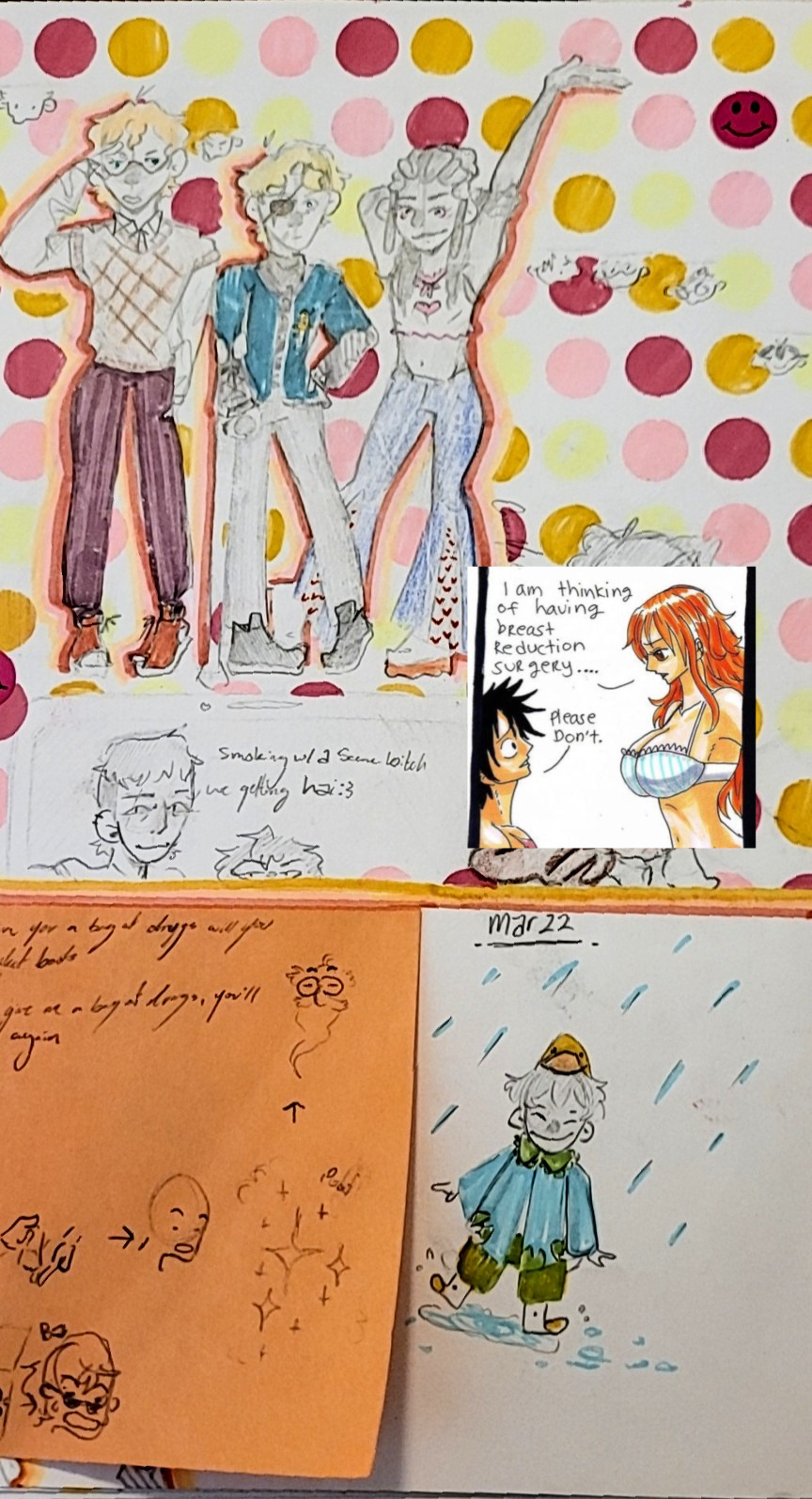

I LOVE THEM THESE ARE SO FUCKIN FUNNY,.
hilariously i am NOT on tiktok but they are so funny even w/o context
#submission#also i adore your art style pls#eric's angry lil face#cadence#eric#marlowe#phillip#draco#david#also the darlowe is so good chef's kiss#if you would like i will literally send you the entire fic kjskjhgkkgjh KJGKJLGGJKH#i might post all of it and just go crazy w it who knows#also thank u for the good vibes always you have my sword and also my shield#my baby boys i am cryiong
4 notes
·
View notes
Text

Since these questions were sent at about the same time, I'm going to answer them together in the same post.
There's actually a great book that came out in 2020 about the geopolitical rivalry between Saudi Arabia and Iran that really heated up following the Islamic Revolution in Iran that overthrew the Shah in 1979 in favor of the theocracy of the Ayatollah Khomeini: Black Wave: Saudi Arabia, Iran, and the Forty-Year Rivalry That Unraveled Culture, Religion, and Collective Memory in the Middle East by Kim Ghattas (BOOK | KINDLE | AUDIO). It's one of the better books that I've read in the past few years and the ideal book to pick up if you're interested in the two most powerful Islamic nations of the Middle East.
Another good book that focuses on both countries is Andrew Scott Cooper's 2012 book The Oil Kings: How the U.S., Iran, and Saudi Arabia Changed the Balance of Power in the Middle East (BOOK | KINDLE | AUDIO).
SAUDI ARABIA
(I've read A LOT of books about Saudi Arabia over the past few years, so I could go on-and-on, but I'll try to limit myself to just a few recommendations!)
•The Kingdom: Arabia and the House of Sa'ud by Robert Lacey (BOOK | AUDIO)
•Inside the Kingdom: Kings, Clerics, Modernists, Terrorists, and the Struggle for Saudi Arabia by Robert Lacey (BOOK | KINDLE | AUDIO)
•Ibn Saud: The Desert Warrior Who Created the Kingdom of Saudi Arabia by Barbara Bray and Michael Darlow (BOOK | KINDLE | AUDIO)
•The Siege of Mecca: The 1979 Uprising at Islam's Holiest Shrine by Yaroslav Trofimov (BOOK | KINDLE | AUDIO)
•Saudi Arabia in the Nineteenth Century by R. Bayly Winder
•King Faisal of Saudi Arabia: Personality, Faith and Times by Alexei Vassiliev (BOOK | KINDLE)
•Kings and Presidents: Saudi Arabia and the United States Since FDR by Bruce Riedel (BOOK | KINDLE)
IRAN
•The Fall of Heaven: The Pahlavis and the Final Days of Imperial Iran by Andrew Scott Cooper (BOOK | KINDLE | AUDIO)
•America and Iran: A History, 1720 to the Present by John Ghazvinian (BOOK | KINDLE | AUDIO)
•The Iran-Iraq War by Pierre Razoux (BOOK | KINDLE)
•A History of Iran: Empire of the Mind by Michael Axworthy (BOOK | KINDLE | AUDIO)
•Iran: A Modern History by Abbas Amanat (BOOK | KINDLE | AUDIO)
•All the Shah's Men: An American Coup and the Roots of Middle East Terror by Stephen Kinzer (BOOK | KINDLE)
•Guests of the Ayatollah: The Iran Hostage Crisis: The First Battle in America's War with Militant Islam by Mark Bowden (BOOK | KINDLE | AUDIO)
•The Twilight War: The Secret History of America's Thirty-Year Conflict with Iran by David Crist (BOOK | KINDLE | AUDIO)
I'll stop there for now. I could list scores of books because I'm fascinated by the history of both countries, their place in the world, and their relations with one another and with the United States. I probably read a lot more about Saudi Arabia and Iran -- and their leaders -- than most people would expect. So I have even more suggestions if you need them...but hopefully this is a good start!
#Books#Book Recommendations#Book Suggestions#Iran#Saudi Arabia#History#Politics#Geopolitics#Middle East#Islam#Books about Iran#Books about Saudi Arabia#House of Saud#Iranian Revolution#Islamic Revolution#Shah of Iran#Ayatollah Khomeini
38 notes
·
View notes
Photo

IN CLASSICAL AND MODERN ART... DEEP REVEALING REFLECTIONS OF THE MASCULINE SOUL!
Tanner, David, “Reflection,” Unknown Date.
The Male Form... In Photography, Art, Architecture, Decor, Style, And Culture Which Moves Beyond Mere Appearance To Reveal The... SOUL.
By LadNKilt: Earl Of Darlow, Ben
Official Residence: County Antrim Northern Ireland; Main Residence: London U.K.;
Second Residence: Kansas City Missouri U.S.A.
LadNKilt Archive | Message Me | Submit | LadNKiltLife (Biography)
37 notes
·
View notes
Text
¿Cuál es la alineación probable del Newcastle vs Manchester United FC para el próximo partido?
🎰🎲✨ ¡Obtén 500 euros y 200 giros gratis para jugar juegos de casino con solo un clic! ✨🎲🎰
¿Cuál es la alineación probable del Newcastle vs Manchester United FC para el próximo partido?
alineación probable Newcastle vs Manchester United FC
Para el emocionante enfrentamiento entre el Newcastle y el Manchester United FC, se espera que ambos equipos presenten alineaciones sólidas y competitivas. Por parte del Newcastle, es probable que veamos a su guardameta titular, Karl Darlow, protegiendo la portería con determinación y seguridad. En la defensa, jugadores como Jamaal Lascelles y Paul Dummett podrían formar parte de la alineación titular, aportando solidez y experiencia.
En el centro del campo, se espera que talentosos futbolistas como Jonjo Shelvey y Isaac Hayden controlen el ritmo del juego y proporcionen pases certeros a sus compañeros de equipo. En la delantera, jugadores como Allan Saint-Maximin y Callum Wilson podrían ser la principal fuente de peligro para la defensa del Manchester United, con su velocidad y habilidad para marcar goles.
Por otro lado, el Manchester United FC podría presentar a su portero estelar, David De Gea, en la portería, brindando seguridad y tranquilidad a su defensa. En la línea defensiva, jugadores como Harry Maguire y Luke Shaw podrían ser piezas clave para detener los ataques del Newcastle y asegurar la portería.
En el centro del campo, la presencia de estrellas como Bruno Fernandes y Paul Pogba podría ser determinante para el control del juego y la creación de oportunidades de gol. En la delantera, jugadores como Cristiano Ronaldo y Marcus Rashford podrían ser los encargados de finalizar las jugadas y marcar goles decisivos para el Manchester United.
En resumen, se espera un emocionante duelo entre el Newcastle y el Manchester United FC, con alineaciones probables que prometen un partido lleno de emoción y buen fútbol. Los aficionados de ambas escuadras estarán ansiosos por disfrutar de este enfrentamiento y ver qué equipo se lleva la victoria en este apasionante encuentro de la Premier League.
jugadores titulares Newcastle vs Man United
En el enfrentamiento entre el Newcastle y el Manchester United, es crucial prestar atención a los jugadores titulares de ambos equipos. En el caso del Newcastle, jugadores como Callum Wilson, el delantero estrella, es fundamental para la ofensiva del equipo. También hay que destacar a Allan Saint-Maximin, un extremo rápido y habilidoso que puede desequilibrar cualquier defensa.
En cuanto al Manchester United, jugadores de la talla de Bruno Fernandes son piezas clave en el medio campo, aportando creatividad y goles al equipo. Además, la presencia de Cristiano Ronaldo en el equipo red eleva el nivel de cualquier encuentro con su experiencia y capacidad goleadora.
En el terreno defensivo, jugadores como Harry Maguire por parte del Manchester United, y Jamaal Lascelles por el Newcastle, son fundamentales para mantener la solidez atrás y evitar goles en contra.
En resumen, tanto el Newcastle como el Manchester United cuentan con jugadores titulares de gran calidad que pueden marcar la diferencia en cualquier partido. Será interesante ver cómo se desenvuelven en este enfrentamiento y cuáles serán los jugadores que logren brillar en el campo y llevar a sus equipos hacia la victoria.
posibles suplentes partido Newcastle vs Man United
En el próximo emocionante enfrentamiento entre el Newcastle y el Manchester United, la pregunta sobre quiénes podrían ser los posibles suplentes en cada equipo es fundamental. Ambos equipos cuentan con jugadores talentosos en sus banquillos que podrían marcar la diferencia en cualquier momento del partido.
Por parte del Newcastle, jugadores como Dwight Gayle y Matt Ritchie podrían ser opciones válidas como suplentes. Gayle es un delantero con experiencia que ha demostrado su capacidad para anotar goles importantes, mientras que Ritchie es un centrocampista versátil que puede aportar tanto en defensa como en ataque.
En cuanto al Manchester United, nombres como Juan Mata y Donny van de Beek podrían ser considerados para entrar en el terreno de juego como suplentes. Mata es conocido por su habilidad para crear oportunidades de gol con pases precisos y disparos letales, mientras que Van de Beek es un centrocampista creativo que puede cambiar el ritmo del partido con su visión y calidad técnica.
En definitiva, el papel de los suplentes en el partido entre el Newcastle y el Manchester United podría ser crucial para el desarrollo y desenlace del encuentro. Con jugadores de calidad esperando en el banquillo, la profundidad de ambas plantillas promete un enfrentamiento emocionante y lleno de sorpresas. ¡No te pierdas este emocionante partido!
estrategia táctica Newcastle vs Man United
El partido entre Newcastle y el Manchester United ha sido uno de los enfrentamientos más emocionantes de la temporada. Ambos equipos han demostrado estrategias tácticas diferentes que han mantenido a los fanáticos al borde de sus asientos.
El Newcastle, bajo la dirección de su entrenador Steve Bruce, ha optado por una estrategia táctica más defensiva, enfocándose en cerrar espacios y aprovechar las oportunidades de contraataque. Han demostrado solidez en la defensa y han sabido aprovechar las jugadas a balón parado para crear peligro en el área rival.
Por otro lado, el Manchester United, liderado por Ole Gunnar Solskjaer, ha optado por una estrategia más ofensiva, buscando dominar el juego a través de la posesión del balón y la presión alta. Han demostrado una gran capacidad para desequilibrar las defensas rivales gracias a la velocidad y la creatividad de sus jugadores en el ataque.
En el enfrentamiento entre ambos equipos, se ha podido apreciar un choque de estilos que ha mantenido la incertidumbre en cuanto al resultado final. La capacidad de adaptación de cada equipo a las estrategias tácticas del rival ha sido fundamental para la resolución de este emocionante encuentro.
En conclusión, el partido entre el Newcastle y el Manchester United ha sido un verdadero espectáculo de estrategias tácticas, demostrando la diversidad de enfoques en el fútbol y manteniendo la emoción de los aficionados hasta el último minuto.
lesiones y novedades Newcastle vs Man United
El partido entre el Newcastle y el Manchester United estuvo lleno de emoción, pero también de lesiones que marcaron el curso del juego. Durante el encuentro, varios jugadores sufrieron lesiones que afectaron el desarrollo del partido.
Una de las lesiones más destacadas fue la del delantero estrella del Manchester United, quien tuvo que abandonar el campo debido a una lesión en el tobillo. Esta baja significativa afectó la estrategia del equipo y permitió al Newcastle ganar terreno en el partido.
Por otro lado, el Newcastle también sufrió una lesión importante en su defensa central, lo que provocó cambios drásticos en la alineación del equipo. A pesar de esto, lograron mantener la compostura y enfrentar al Manchester United con determinación.
A pesar de las lesiones, el partido estuvo lleno de novedades y sorpresas. El Manchester United logró finalmente imponerse con un gol en los minutos finales, dejando a los aficionados con el corazón en un puño.
En resumen, el enfrentamiento entre el Newcastle y el Manchester United estuvo marcado por las lesiones que afectaron a ambos equipos, pero también estuvo lleno de emoción y novedades que mantuvieron a los espectadores al filo de sus asientos.
0 notes
Text
Eddie Howe transferlist two Newcastle players for January
According to The Athletic, Ryan Fraser and Karl Darlow have both been given permission to quit the team this month.
Fraser actually wanted to leave at the beginning of preseason, as reported by David Ornstein and North-East writer Chris Waugh, but Newcastle’s inability to find a fresh winger caused him to stay on Tyneside.
It is now believed that the 28-year-old will be allowed to depart the team…

View On WordPress
0 notes
Photo

BOOK REVIEW: ADVENTURES IN MODERN RECORDING: FROM ABC TO ZTT by Trevor Horn (2022)
This is a Trevor Horn production! A book begun quite a few years ago and completed recently during lockdown.
Trevor has such a great track record, and his new hardback of 320 pages is a testament to that long and successful session musician/singing/recording career - a sermon given in 24 (song) lessons from the mount of pop synthesiser!
Indeed, Horn is biblically described as being, “the man who invented the ‘80s”. Pop songs burning just as bright as the stars, including:
1983 Yes ~ ‘Owner Of A Lonely Heart’ (UK No.28 / US No.1)
1983 Frankie Goes To Hollywood ~ ‘Relax’ (UK No.1 / US No.10)
1984 Frankie Goes To Hollywood ~ ‘Two Tribes’ (UK No.1 / US No.45)
1985 Grace Jones ~ ‘Slave To The Rhythm’ (UK No.12)
Chaper 15; page 229: “ ‘Slave To The Rhythm’ Is a record that shouldn’t have happened. It had its seeds in 1984 when, in the wake of the success of ‘Relax’, we were hunting around for a follow-up. You may recall that Bruce Woolley had written a song called ‘Slave To The Rhythm’ with Simon Darlow, which we tried out with Frankie. It didn’t work out particularly well, so it was shelved.
Chris Blackwell, the owner of Island Records at the time, was putting together a greatest hits album for Grace Jones and suggested that we make a single of ‘Slave’ with her for the album. Bruce and I were long-time fans of Grace.”
1989 Simple Minds ~ ‘Belfast Child’ (UK No.1)
Wearing his distinctive rounded glasses, Trevor Horn already looks like a Buggle in the photos section - A Portrait Of The Artist As A Young Boy (aged seven).
From ‘Video Killed The Radio Star’ to ‘Videotheque’ to loaning out his studio for free (and not for Dollars) so that Midge Ure could produce Bob Geldof’s Live Aid project single, ‘Do They Know It’s Christmas’ ADVENTURES IN MODERN RECORDING is a Lexicon Of Love.
All flash no trash. Out now on Nine Eight Books.
Rating: 10/10
More on the book below; Trevor Horn being interviewed by Mark Ellen and David Hepworth.
https://youtu.be/j1JBignUPiw
Mark Watkins, Dare radio, 6 November, 2022.
0 notes
Text
"THE MARVELOUS MRS. MAISEL" Season One (2017) Episode Ranking

Below is my ranking of the Season One episodes of the Amazon Prime series, "THE MARVELOUS MRS. MAISEL". Created by Amy Sherman-Palladino, the series stars Rachel Brosnahan as Miriam "Midge" Maisel:
"THE MARVELOUS MRS. MAISEL" SEASON ONE (2017) EPISODE RANKING

1. (1.08) "Thank You and Good Night" - Housewife-turned-stand up comic Miriam "Midge" Maisel and her manager, former cafe employee Susie Myerson deal with the repercussions of Midge's off-script take down of famous comedienne Sophie Lennon. Midge and her estranged husband Joel Maisel briefly reunite for their son's birthday.
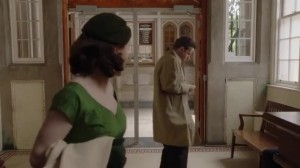
2. (1.02) "Ya Shivu v Bolshom Dome Na Kholme" - Midge's life falls into a tailspin in the wake of Joel leaving her. Their parents butt heads in an attempt to keep the couple together. Susie pushes Midge to seek a career as a stand-up comic.

3. (1.07) "Put That on Your Plate" - With Susie's help, Midge hones her act at the Gaslight Cafe. Midge's father, Abe Weissman, surprises the women with a dinner guest, sending her mother Rose into an emotional spiral. Midge stirs up controversy after meeting a big-time comic, Sophie Lennon.

4. (1.01) "Pilot" - Midge seemed to lead the perfect life with Joel and their children. But when his dreams of becoming a stand-up comic bombs at the Gaslight, Joel blames Midge and leaves her. A drunken Midge returns to the club and engages in a comic routine that leads to her arrest.

5. (1.04) "The Disappointment of the Dionne Quintuplets" - Susie shows Midge the ropes during a tour of New York comedy clubs. Rose takes a bit too much pleasure in Midge and the children moving in with the Weissmans.
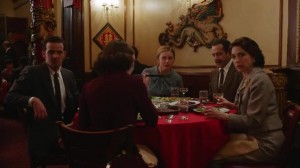
6. (1.06) "Mrs. X at the Gaslight" - Susie becomes upset when she learns that Midge has been performing her act at private parties. Abe is thrilled when he receives a job offer from Bell Labs. The Weissman family celebrate Abe's job offer at a local Chinese restaurant, where they encounter Joel and his mistress, Penny Pann.

7. (1.03) "Because You Left" - After her second arrest, Midge finds herself in legal trouble when she is forced to face a judge in court. Abe approaches Joel's father, Moishe Maisel, with an interesting proposition. Legendary comic Lenny Bruce offers some unconventional inspiration for Midge's act.

8. (1.05) "Doink" - Midge gets a job at B. Altman, a Manhattan department store, where she makes new friends. She also hires an unemployed comedy writer, an act that proves disastrous for her budding career. Joel's relationship with Penny Pann meets with disapproval from his parents, along with the wife of his friend/co-worker Archie Cleary.

#the marvelous mrs. maisel#amazon prime#rachel brosnahan#alex borstein#tony shalhoub#michael zegen#midge maisel#marin hinkle#kevin pollak#luke kirby#bailey de young#joel johnstone#will brill#jane lynch#cynthia darlow#caroline aaron#david paymer
1 note
·
View note
Text
WFF '21 Review: 'Drinkwater' is a quirky, Canadian, familiar coming of age film
#WFF21 / @whisfilmfest Review: 'Drinkwater' is a quirky, Canadian, familiar coming of age film
Stop me if you’ve heard this one before: a teenager is hopelessly in love with a beautiful girl and signs up for some kind of feat to impress her. He trains for this event and trains some more. At least once, he loses faith, but along the way, he grows up a little, turns his bully into a friend, and in the end, gets with the girl who has been his friend the whole time.
If any of this sounds…

View On WordPress
#Alex Zahara#Bob Frazer#Chloe Babcook#Daniel Doheny#David Allan Pearson#Eric McCormack#Jana Benoit#Jordan Burtchett#Linda Darlow#Louriza Tronco#Naika Toussaint#Vincent Cheng#Whistler Film Festival#Whistler Film Festival 2021
1 note
·
View note
Text
Kung Fu: Inside The History of a Martial Arts Classic
https://ift.tt/2Q3B4LS
It’s been a long journey for The CW to snatch that Kung Fu pebble from the master’s (Warner Bros.) hand, but the new reboot of Kung Fu could not have come at a better time.
Issues of diversity and representation have been at the forefront of our cultural conversations for years now. The rise in Asian hate crimes – nearly a 150% increase in 2020 – has made #StopAsianHate a frequent trending topic on social media. For The CW to launch a show with a Chinese leading actress and a largely Asian cast right now makes a bold statement for inclusivity that lives up to the network’s longstanding slogan “Dare to Defy.”
What’s more, Kung Fu is promoting itself as an Asian family drama which could fill a newly opened gap. Two wildly successful Asian family sitcoms just went off the air – ABC’s Fresh Off the Boat ended its six-season run in 2020 and Kim’s Convenience announced that their final episode after a five-season run will be April 13, 2021 (In the wake of Kim’s Convenience, CBC is launching a spinoff series, Strays, following the character of Shannon Ross, the only white actor credited in show’s opening). This leaves the door wide open for Kung Fu to capture fans of Asian family dramas. Plus it’s The CW, a network that thrives on soap opera-esque dramas.
CW’s reboot is a complete reimagining of Kung Fu, but what of the legacy of the original franchise? Will this new version bring honor to the Kwai Chang Caine a.k.a. Grasshopper? The original Kung Fu series was groundbreaking in its own way. The show garnered critical acclaim including three Primetime Emmys and two Golden Globe nominations. Even though David Carradine’s Kwai Chang Caine would be called out for whitewashing today, with its heavy reliance on Daoist philosophy, Kung Fu provided many Americans with their first taste of many aspects of Chinese culture, especially Shaolin martial arts. It also had the largest Asian supporting cast of any show for decades to come.
The Shaolin Temple Days
When the original Kung Fu premiered in 1972, it was the right time too. The pilot was such a big hit that the network decided to show it again (remember this was long before the invention of VHS – back then your only chance to see a show was to watch it when it was broadcast). However, the second showing was preempted by President Richard Nixon shaking hands with Chairman Mao Zedong. China was opening its bamboo curtain to America at the same time Kung Fu was telecast.
Kung Fu ran for only three seasons on ABC and yet it holds a special place in the hearts of its long standing fans. Kwai Chang Caine was a barefoot half-Asian mendicant monk from the Shaolin Temple who travelled the old west in search of his long-lost half-brother, Danny Caine (Tim McIntire). Caine was a wanted man because he took revenge. He killed the Emperor’s nephew who killed his beloved blind master, Master Po (Keye Luke). Beyond casting almost every Asian actor in the business back then, Kung Fu had an astonishing list of guest stars like Gary Busey, Jodie Foster, Harrison Ford, William Shatner, and many others.
The Chinese Connection: Bruce Lee Vs. Kwai Chang Caine
For decades, it was rumored that Kung Fu was ripped off from martial arts legend Bruce Lee. Lee had written a treatment that was remarkably similar – a story of Chinese immigrant martial arts master who landed in America during the Wild West era. However, in the definitive biography Bruce Lee: A Life, biographer Matthew Polly uncovered substantial evidence that Warner Brothers already had Kung Fu in development prior to Lee’s pitch. Nevertheless, Lee’s daughter, Shannon Lee, claims that her father auditioned for the part of Caine and was rejected because, ironically, he was Chinese. She went on to develop her father’s treatment into Cinemax’s Warrior (another recent show with a predominantly Asian cast that was cancelled last year).
After the original show ended, Carradine returned to the iconic role of Caine several times. In 1986, Kung Fu: The Movie aired on ABC, reuniting Carradine with Keye Luke and introducing Caine’s estranged son Chung Wang. Even more ironic, Chung Wang was played by none other than Bruce Lee’s son, Brandon Lee.
Read more
TV
Warrior: The Historical Inspiration for Dylan Leary
By Gene Ching
Movies
How Batman: Soul of the Dragon Pays Homage to 70s Kung Fu and Bruce Lee
By Gene Ching
Kung Fu: The Movie was a steppingstone towards a spinoff series attempt, Kung Fu: The Next Generation, with Brandon Lee playing Johnny Caine. Carradine was not involved in this series. Set in modern times instead of the Old West, Johnny Caine was the great grandson of Kwai Chang Caine, but not the Kwai Chang Caine of the original series. The TNG Kwai Chang Caine was named for his great-grandfather – Carradine’s original character – and played by David Darlow. Brandon Lee was cast as both Kwai Chang Caine’s son and his great great great great grandson. Kung Fu: The Next Generation was not picked up. It was only telecast on an unusual short-lived TV showcase called CBS Summer Playhouse, which ran failed pilots every week. Six years later, Brandon Lee died in a tragic on set accident while filming The Crow.
Twenty years after the original series, David Carradine reprised the role of Kwai Chang Caine, or rather the grandson of Kwai Chang Caine, also named Kwai Chang Caine (not the father of the TNG Kwai Chang Caine because the failure of the pilot removed it from canon). That was the first real reboot of the series – Kung Fu: The Legend Continues. Set in modern times again, Caine was paired with a new son, Detective Peter Caine (Chris Potter). The series ran for four seasons, logging twenty-four more episodes than the original.
After that, Carradine never returned to Caine. He went on to promote martial arts with his book, Spirit of Shaolin, which he wrote in 1991, and some instructional Kung Fu videos that he made in the mid-90s. Carradine was never able to completely shake being typecast by the iconic role of Caine. Over the course of over 200 roles, a few more Carradine parts echoed Grasshopper. Fans were delighted to see him play the flute as Bill in Tarantino’s Kill Bill films (the flute was Caine’s signature accoutrement). Tarantino also referenced Kung Fu in Pulp Fiction when Jules (Samuel L. Jackson) tells Vincent (John Travolta) that he plans to walk the earth like “Caine in Kung Fu.”
In 2008, Carradine played “Crane”, a martial art monk just like Caine, in Kung Fu Killer, a two-part mini-series for Spike TV. Carradine claimed that the role was based on an actual historical figure, which he alleges is how the production worked around Warner Bros.’ copyright on Caine. But Carradine was never able to provide the name of that historical figure. He believed that Crane and Caine were ‘diametrically opposed’ but aside from being more violent (in one fight, Crane knocks an opponent so hard that his spine graphically bursts out of his back) viewers are hard pressed to separate them. The series was slated to have three more installments, but those never happened.
The Barefoot Journey to The CW
Kwai Chang Caine had to walk a lot of rice paper before the character could become this new incarnation of Nicky Shen (Olivia Liang) for CW’s reimagining of the franchise. The first major talk of reboot was back in 2011 (on Halloween no less). Bill Paxton (Aliens, Predator 2) was in talks to direct a screen adaptation. John McLaughlin (Black Swan, The Patriot) was tapped to write the script. The production was from Legendary Entertainment and plans were being made to shoot in China. Paxton said they had intended to follow the original story more or less – Caine ventures across the American West of the 1870s in search of his birth father instead of his half-brother. Paxton claimed that his new production would enrich the scale and grandeur to the level that the show always deserved. This was to be feature films under Warner Brother’s Chinese cooperative venture, Legendary East. As the project developed, other writers who became associated with the reboot film included Cory Goodman (Priest) and Rich Wilkes (xXx)
In 2014, Baz Luhrmann (Romeo + Juliet, Moulin Rouge!) was in talks to direct Kung Fu for Legendary. If the deal had been signed, Luhrmann planned to rewrite McLaughlin’s script. Paxton died in 2017 but his name had faded from talk of the reboot prior to his passing.
In an unexpected twist, Universal announced that it was opting Kung Fu for a feature length film in early 2020. At the helm is none other than stuntman-turned director David Leitch (John Wick, Deadpool). Leitch has also been attached to a remake of Bruce Lee’s Enter the Dragon (another property with a long history of attempted remakes). However, since the initial announcements, there’s been no information on the further development on either project from Leitch.
On the TV side of things, Fox grabbed Kung Fu in 2017 for a new series. Greg Berlanti (Arrow, The Flash) came on board to produce with Wendy Mericle (Arrow, Desperate Housewives) penning the script. This incarnation was the first mention of changing the gender of the main protagonist. The new lead was to be Lucy Chang, a Shaolin nun. Instead of being set in the Old West, she was to be living in the 1950s. And instead of searching for her half-brother, it was her kidnapped child.
In a successive treatment, Lucy was set in modern times. She was to inherit her father’s Chinatown Kung Fu school, only to discover that it secretly operated as a center to help those in desperate need. Lucy was partnered with a Korean War veteran named J.T. Cullen. The reboot moved to the CW in 2019 with Christina M. Kim (Blindspot, Hawaii Five-0) taking over as writer and producer and Berlanti still attached as a producer. The story is reimagined with Nicky Shen as a young Chinese American woman in contemporary times, who leaves to find herself at a monastery in China, and then returns to her family in America.
In the pilot, there’s no explicit connection given between Nicky and Kwai Chang Caine so far (save for the quick appearance of a grasshopper). Kung Fu is a complete re-imagining, so all bets are off. But as the season progresses, who knows what references and homages are possible? Reboots thrive on their Easter eggs nowadays, and even if Nicky isn’t within the Caine bloodline, Kung Fu will be well served by tucking some call-backs to the original show.
Will Nicky have to walk rice paper and snatch pebbles from her master’s hand? Will she get those classic Shaolin Dragon and Tiger forearm brands? If she does then perhaps Kung Fu will be the right show for its time while still honoring what came before it.
cnx.cmd.push(function() { cnx({ playerId: "106e33c0-3911-473c-b599-b1426db57530", }).render("0270c398a82f44f49c23c16122516796"); });
Kung Fu premieres on the CW on April 7, 2021.
The post Kung Fu: Inside The History of a Martial Arts Classic appeared first on Den of Geek.
from Den of Geek https://ift.tt/3sYmG5U
2 notes
·
View notes
Text
Only a day or two ago I was notified that I was in contact with some people tested for and found positive for Covid-19, this came as nothing un expected, I was in contact with hundreds of people many from Europe recently. Then, as you know we are experiencing, most Universities, Libraries and Book Shows have been indefinitely closed, and because of this; many of us find or try lively-hood’s challenged. In a situation where it seems that there is little to do that will improve the current situation any faster than time will take its course, I have turned to reading and writing. I have been researching, as best as I can from home, fifteen books which are new to my stock. There are many more stuck in Europe and this gives me hope. It is the first day of spring and I awoke to a beautiful snow squall… In like a Lion..
And here are the fruits…

1). 355J Bible Saint Jerome, Gabriello Bruno (active 1480-1514.)
Biblia cum summariis concordantiis : diuisionibus: quattuor repertoriis p[ro]positis: numeriq[ue] foliorum distinctione: terse et fidelit[er] imp[re]ssa. { With table of Gabriel Brunus }
[Lyons]: Jean Pivard, 29 Jan. 1500 & 1. $ 15,000.
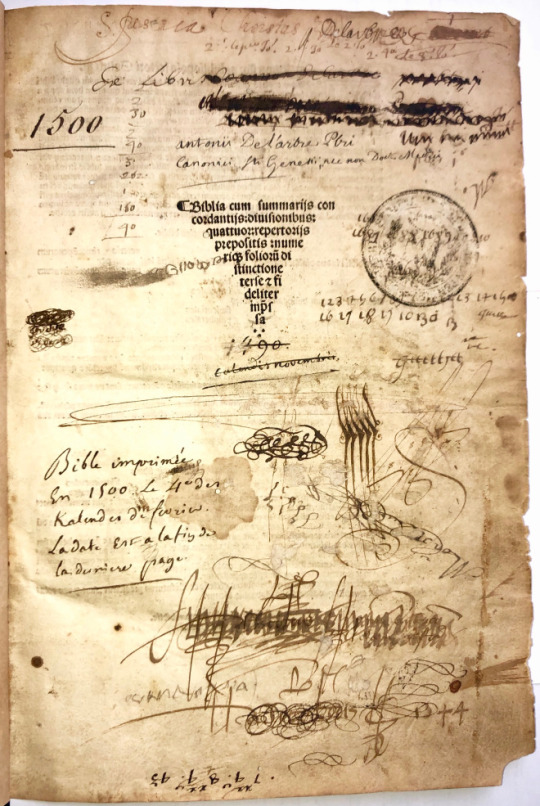
Impresserunt aute[m] solertes viri Franciscus Fradin et Ioha[n]nes Piuard socij impressores. …,]
Folio inches, &8 ç8 , a8 b6, c-z8 A-Z8 Aa8 Bb8; aa-cc8 dd10. Bound in original full calf over wooden boards with 10 brass bosses.
This edition corresponds with the edition printed by Fradin and Pivard in 1497. There are the same tables, summaries, &c.; and the arrangement of the books and the readings are alike. At the end of the subscription we read: “Impressit autem solers ori Johänes Pivard impressor. Deo sint sempiterne gratie.”
Pivard,who was working alone from 7 March 1498 to 1501, Started printing with François Fradin in 1497 (Goff B602) ISTC lists15 titles solely printed by Privard.
Goff B604; HC 3128; GfT 1883, 1884; Pell 2341; CIBN B-426; Arnoult 288; Girard 108; Parguez 213; Polain(B) 4210; IBE 1040; SI 764; Martín Abad B-134; Sallander 2098; Bod-inc B-312; Sheppard 6736; Pr 8670; GW 4281. (Gutenberg-Jahrbuch 1965 p140-3)

Copinger, Incunabula Biblica, 120; Darlow–Moule 6090; Sheppard 6736.
U.S. copies: Boston Public Library, General Theological Seminary, Jewish Theological Seminary of America, Library of Congress, Rare Book Division, Southern Methodist Univ., Bridwell Library (418 ff)
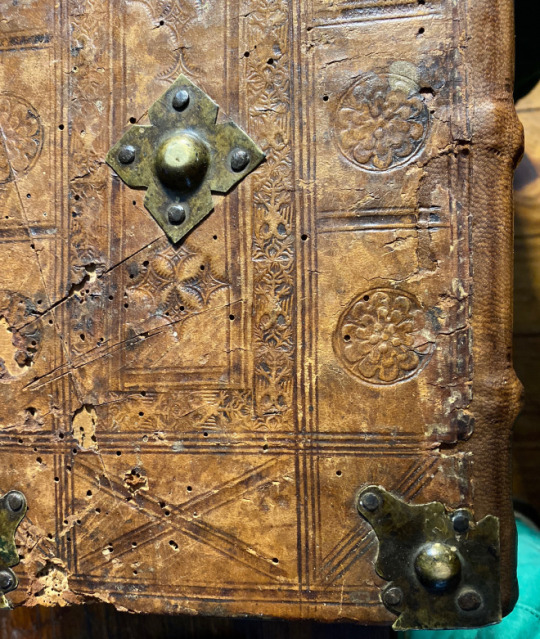
https://data.cerl.org/istc/ib00604000
◊
◊ ◊
◊
2) 353J Alberto da Castello (ca. 1460-1522)
Rosario della gloriosa Vergine Maria : con lle sttattiionii & iindullgenttiie delllle chiiese di Roma perr tutto L’’anno.
In Venetia : Presso la compagnia de gli Vniti,1585. $7,800

Octavo. 6 x 3 3/4. A-Z, Aa-Ii8. A later edition of the first ‘Rosary Book” in Italian.
This book has a wonderful contemporary binding, recently expertly rebacked. It is of red Morocco with gilt center images and borders gilt, with angels. Certainly these books were
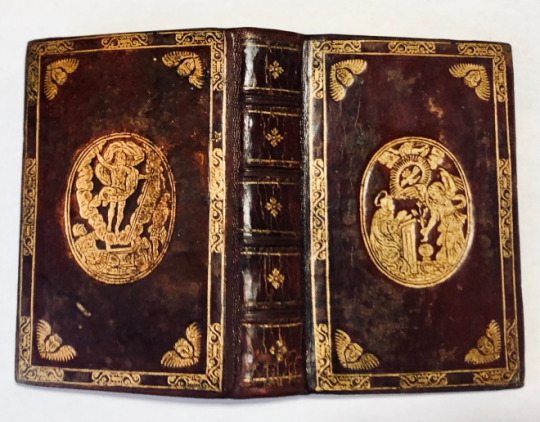
very popular, that said, very few copies have survived. This edition is represented on OCLC by only two copies worldwide. 1 US copy Saint Benedict/Saint John’s University. (SJU Alcuin Arca Artium Rare BookBX2163 .C37 1585). [The authorship of the work and the woodcuts are attributable to the Dominican Friar Alberto da Castello, identified as author or editor at the authorizations of the Venecian Inquisition, given 5 April 1521. (Francesco Pisano)]
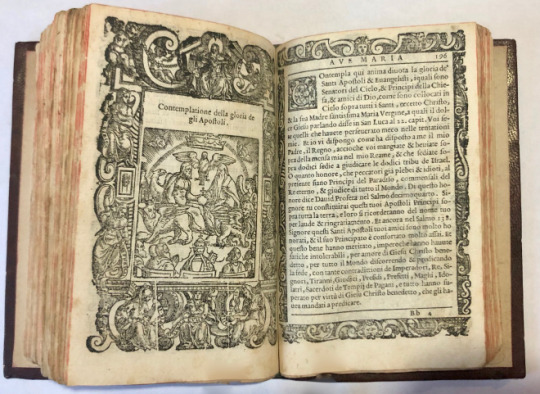
Over 150 woodcuts (including repeats) comprising almost full-page cuts (1 on t.p.) within borders. All had previously appeared in earlier editions. Ornamental and pictorial border pieces on almost every leaf. ( The wood cut on leaf 173v is upside down in the border!) Each wood cuts represent the “Mysteries of the Rosary”
“From the beginning, publications on the Rosary came accompanied by lavish xilographic illustrations. The most striking of these can be found in the edition of the Rosario della gloriosa Vergine Maria by Alberto da Castello from 1521 [Fig. 14.1], which contains a wealth of illustrations. This clearly shows that the Rosary was not just an oral recitation, but was also a contemplative prayer engaging the imagination, a combination later mirrored by the exercises of Ignatius of Loyola.
Alberto da Castello, born in the middle of the fifteenth century in Venice, joined the Dominican order around 1470 and wrote several devotional, liturgical, historical and canonical texts. In the Epistola prohemiale of his Rosario della gloriosa Vergine Maria he says that he wrote the meditations and organised the images ‘acciò che gli idioti che non sanno legere habbino el modo de contemplare gli divini beneficii et de questa contemplatione ne habbino qualche frutto spirituale’.( fol. 6r. ‘So that even the illiterate have a means to contemplate gifts of the divine and to receive spiritual fruits from such contemplation’ (translations are mine).He states that he writes especially for the ‘ignoranti, illetterati, idioti’, and that a good Christian must hold the mysteries of the Rosary deep in his heart. (Literary and Visual Forms of a Domestic Devotion: The Rosary in Renaissance Italy. Erminia Ardissino)

The mysteries of the rosary were introduced by Dominic of Prussia sometime between 1410 and 1439. This gave each decade of the rosary a unique quality. Each mystery leads us to ponder very specific events in the lives of Jesus and Mary and the lessons they hold for our own lives today.
The Rosary has a ritual aspect that individual prayers lack, and it is highly structured. It entails the recitation of 150 Ave Marias, clustered in groups of ten, preceded by a Pater noster and the proposition of a ‘mystery’ upon which to meditate. This number of 150
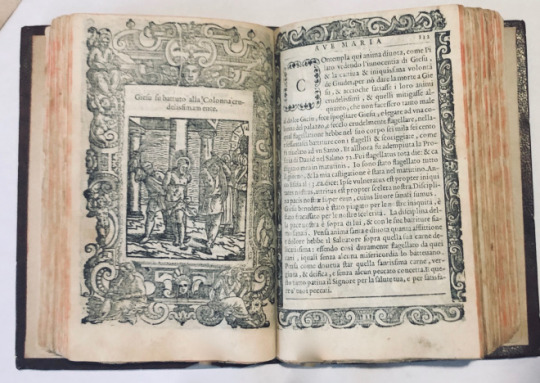
Ave Marias seems to be designed to correspond to the 150 psalms in the Davidic psalter, which is why the Rosary is also known as the ‘Virgin’s psalter’. It does not consist only of repetitive prayers, however, but also entails meditations. Indeed, the Rosary created by Dominic of Prussia was a kind of meditation on the life of Christ and Mary. In his Liber experientiarum he ‘explicitly claimed to be the first to have composed a series of fifty points on the life of Christ that were to be meditated on while reciting the Ave Marias’.
Sander 6572-6573. See: Essling 2124
)0(
100 full page plates and a volvelle!
3) 382J Jan David. 1545?-1613.
Veridicus christianus: auctore P. Joanne David … Editio altera, auctior.
Antverpiæ ex officina Plantiniana, M. DCVI. $6,500

Quarto 8 1/2 X 6 inches ‡4, ‡‡4, A-Z4, a-z4, Aa-Ee4.+ 100 Numbered Plates. Withspecial engraved t.p. with allegorical depiction of Christ carrying the cross, surrounded by ten artists at easels painting scenes from his life (as well as a few questionable profane subjects).
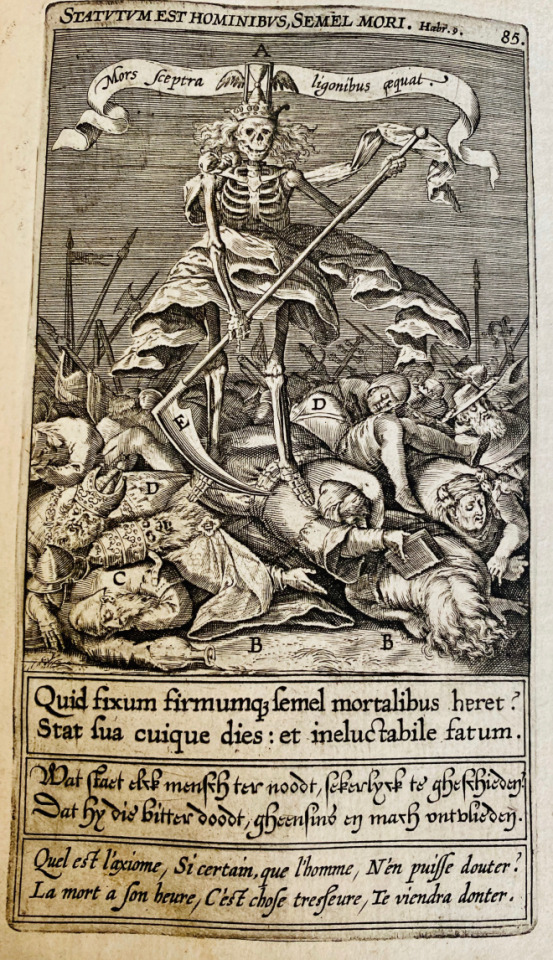
The text is divided into 100 chapters, each with an allegorical engraving incorporating letters keyed to the explanatory text and with marginal references. Each of the 100 numbered plates has a single line of Latin at the head giving the subject, with two-line explanatory verses below the allegorical engraving in Latin (roman letter), Dutch (civilité) and French (italic) First plate (following [2 daggers]4) is added title leaf for the ill., which were also published separately; see Bibliotheca Belgica. The added title reads: Icones ad Veridicvm Christianvm P. Ioannis David e Societate Iesv At the end is Device with compasses and the motto “constantia et labore” on Ee4r . This book is notoriously found defective in one way or another, this copy is perfect and complete.
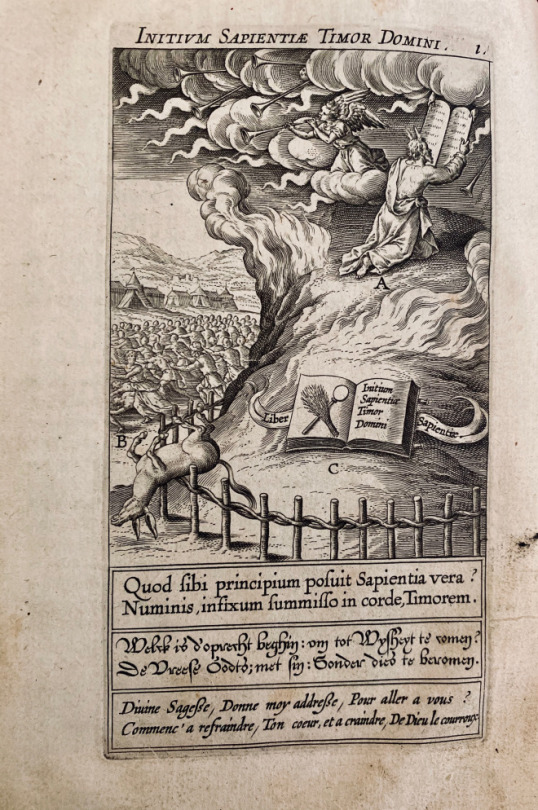
This copy is bound in full contemporary blind stamped calf over wooden boards with two working clasps.
The Veridicus christianus: is followed by the “Orbita probitatis ad Christi imitationem veridico Christano subserviens”: p. 351-374; which preceds a volvelle plate for use in locating specific passages.
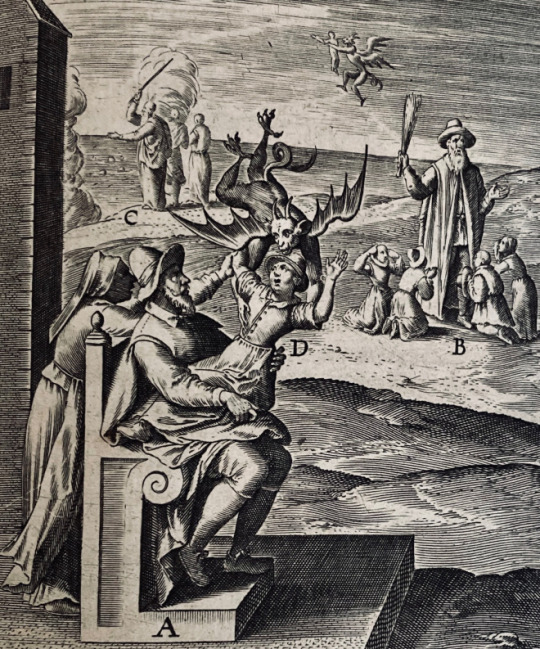
This text contains a series of images with accessible (sometimes to a fault) moral or religious messages. These illustration swarns against opening the senses to temptation lest death and moral decay take up residence in one’s soul.
The Veridicus Christianus emphasizes the Society of Jesus’ investment in thinking in, though, and about visual images that exemplify the supreme mystery of God. Published as a tool of devotion and meditations, it features one hundred chapters that encompass a wide range of topics for reflection. Each chapter incorporates an extensive commentary that interprets the emblematic image David too follows the order in which we apprehend things with our senses, beginning with a visual representation at the head of each chapter. Then comes the explication. The symboli explicatio was considered necessary because cultivated readers would be more susceptible to a reasoned argument than a picture.
Here are images of the vovell. The centers of the engraving and the volvelle (through which a string passes) are reinforced with small paper roundels printed with the monograms of Christ. The numbers are keyed to an “Indiculus orbitae” that follows (Bb1r-Bb2r). There a number, having been selected, is provided with a phrase from various Latin authors (listed on Bb2v), and a reference to one of the hundred sections that comprise the main text. It is suggested in Bibliotheca Belgica that this game may have been intended as a pious alternative to such superstitious books as Thuys der fortvnen.
)0(
4) 312J. Domenico Cavalca. (1270?-1342)
Pungi lingua
[Baptista de Tortis]: Venexia, Adi .viiii. de Octubrio. 1494 $12,000
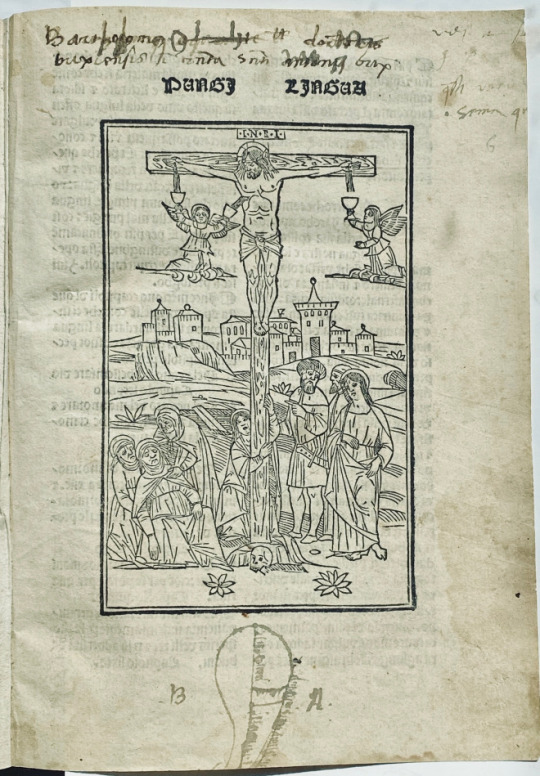
Quarto (200 x 145 mm); [80] pages. a-k8. Large woodcut depicting the crucifixion on the frontispiece, First Venetian edition with the beautiful woodblock published here for the first time. This copy has a beautiful initial “A” in gold, blue, red and green, a colorful coat of arms. This copy is bound in modern carta rustic with a gold title on an orange label

This is a treatise on the dangers of the misuse of the language it was, as you might expect quite popular . Written by the Dominican monk who was a contemporary of Dante and among the first to write in the vernacular, and one of the most successful translators of holy texts.
Aside from Biblical illustrations, the Pungilingua has many exempla drawn from many other sources including some not includes in the Alphabetum narratinum. Most of the stories are told in one to three lines, and many contain commerce with the Devil, one time disguised as a horse. In the prologue Cavalca mentions that he gathered his exempla from many sources “alcune poche cose” . One of the major sources is the Summa Vitiorum by Peraldus. but he also quite a few profane authors , Seneca, Socrates, Cicero, Valerius Maximus. That said, quite often Cavalca attributes the wrong author. Cavalca writes as though he was speaking to the reader in person useing phrases like “Io per me credo” and “Oimé “ Introducing unique stories and words, He refers to someone as double-tongued as a “tecomeco” (bilingue) . He refers to a sleight of hand trick ,called “gherminella” a word which was used later by Boccaccio. This is an important book in Italian literary history, and the Italian vocabulary leaving many contemporary proverbs and descriptions of medieval life.
Goff C342; H(Add)C 4776a; R 116; Pell 3448; CIBN C-195; IGI 2637; Essling 750; Sander 1853;
Pr 4649; BMC V 328; GW 6413
One copy in Goff.
Huntington Library.
Queried Location: New York NY, Manhattan College: sold Christie’s (NY) 1 June 1991 lot 41 (current whereabouts unknown)

***
***
5) 350J. Richard FitzRalph (Ricardus Radulphus Armacanus pseudonym) (circa 1300-1360)
Summa Domini Armacani in Questionibus Armenorum noviter impressa et Correcta a magistro nostro Johanne Sudoris. Cum aliquibus Sermonibus eiusdem de Christi dominio.
Paris: Jehan Petit et ponset le Preux, (Venales habentur in vico divi Jacobi sub Lilio aureo) 1512. [Privilège octroyé à Jean Petit et Poncet Le Preux daté du 12 mars 1511 (1512 n. st.) et prenant effet le 15 juillet 1512.]. $24,000
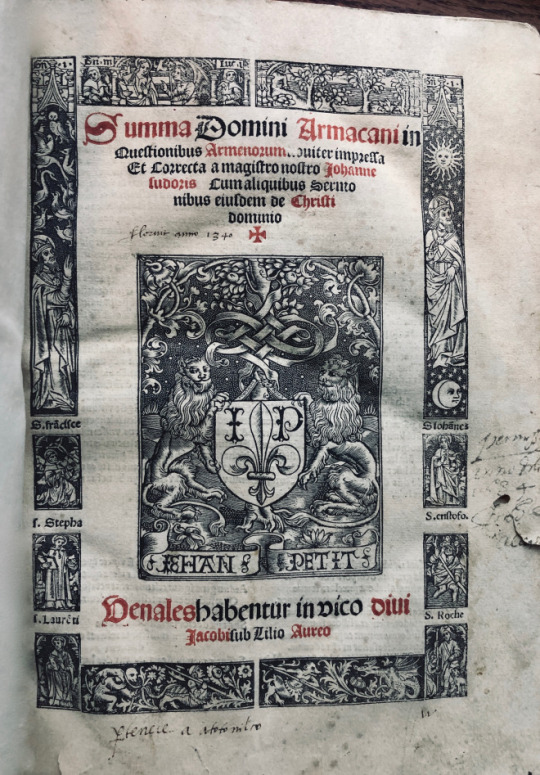
Small Folio 275 x 201 mm. A6 a-z6 &6 A-E6 F4. [6], 177 [i. e., 178] leaves. This copy is bound in a Remboîtage of later limp vellum; contents toned and brittle, lightly damp wrinkled with marginal damp staining at beginning and end, contemporary inscriptions on title and scattered underscoring and marginalia, wormhole through blank outer margin of approximately the first 30 leaves, paper crack in o1 not affecting text, last leaf reinforced in outer margin on verso. A Mexican Augustinian branded ownership mark on bottom edge.
This is the only printed edition of the Summa in Questionibus Armenorum which is an examination of alleged Armenian doctrinal errors, the chief dogmatic work by an Irish theologian and prelate involved in negotiations between the papal court at Avignon and Armenian representatives over the reconciliation of the Roman and Armenian churches.
FitzRalph, whose Defensorium curatorum was first published circa 1483, was one of the earliest Irish authors to appear in print. Renouard-Moreau II, 314;
Shaaber M119; not in RBH or ABPC. Moreau, B. Inventaire 1512- 314; Index des livres interdits, t. IX, p. 86 (n° 50/499; Page de titre en rouge et noir dans un encadrement de plaques gravées sur métal, marque de Jean Petit (Renouard, 890) Adams, F-550
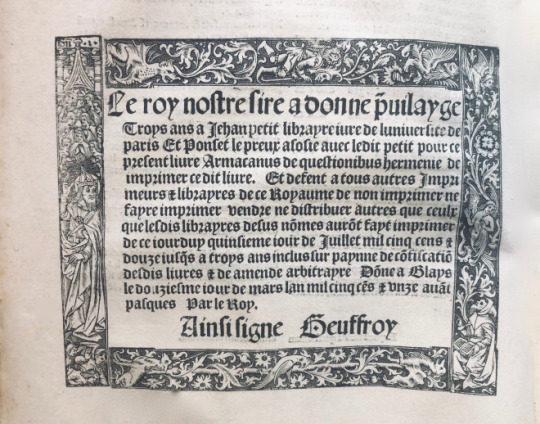
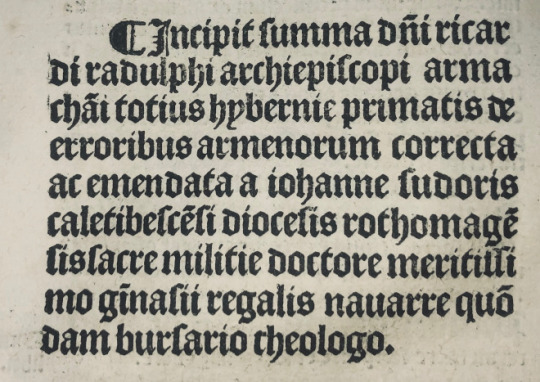
><><><><><
6) 358J Jacobus de Gruytrode 1400-1475
Speculum animae peccatricis
[Memmingen : Albrecht Kunne, about 1490] $6,500

Quarto , [28] ff, 33 lines, the first initial (5 lines) is painted in white and blue on a golden background, upper and left margin richly decorated in red, purple, blue and gold and with two red beasts. 19th c. binding in half leather, title gilt on spine, all edges gilt. Sometimes falsely attributed to Dionysius Carthusiensis, the Speculum is now attributed either to Jacobus de Gruytrode (cf. Bloomfield) or to Jacobus de Clusa (cf. L. Meier, Die Werke des Erfurter Karthäusers Jakob von Jüterbog, Münster, 1955).

Speculum animae peccatricis is a work of spiritual edification which consists of seven sections: on human misery, sin (especially lechery), penance, rejection of the world, the vanity of human wishes, death and hell and heaven.
Firste of the filthenes and miserie of man. Below are the chapter in English
Secounde of the synnes ingeneralle and of their effectis.
Thyrde howe they ought hastely with all diligence to do penaunce.
Fourth howe they ought to fle the world.
Fyfthe of the false Riches and vayne ho∣noures of the worlde.
Sixt howe they ought to drede deth.
Seuenth of the Ioyes of paradyse and of the paynes of hell.
There is no modern critical edition of the text. Among the devotional books by the Flemish mystical writers of the fourteenth and fifteenth centuries, none was more popular on the Continent and in England during the early Renaissance than the Speculum aureum animae peccatricis or The mirroure of golde for the synfull soule, which Lady Margaret Beaufort translated into English. Since the sixteenth century, bibliographers have listed the Speculum as the work of the Carthusian monk Jacobus de Gruytroede, prior of the Liége Charterhouse from 1440 to 1475, yet the English version is always attributed to his friend Denis de Leuwis or Dionysius the Carthusian, as he is better known. The question of authorship may be satisfactorily settled as the result of recent research by an English Carthusian scholar in the library of the Certosa in Farneta. He noted that the editors of Dionysius’s Opera omnia (Tournai, 1913) explain how the error in authorship began. In volume xlii they point out that, owing to the Carthusian tradition of anonymity during a monk’s lifetime, the Speculum was printed anonymously until 1495, in which year the Nuremberg printer Paul Wagner first issued it as a work by Dionysius. He found the manuscript of the Speculum in the library at Ruremond, where Dionysius was prior until his death in 1471, and supposed it was written by him, as were the other works he intended to print. The two priors were close friends, and dedicated several of their works to each other. Nugent E.M. (1969) Jacobus de Gruytroede. In: Nugent E.M. (eds) The Thought & Culture of the English Renaissance. Springer, Dordrecht
Goff S644; HC 14899*; Pell 4313; CIBN S-333; IGI 5001; IDL 2532; Schlechter-Ries 1003; Voull(B) 1617,5; Schmitt I 1614,2; Hubay(Augsburg) 1141; Hubay(Eichstätt) 538; Sack(Freiburg) 1951; Walsh 988; Bod-inc S-258; Sheppard 2032; Pr 2804; BMC II 608; BSB-Ink I-23; GW M10734
U.S. copies;Harvard ,Emory, Columbia ,Huntington Library
Southern Methodist Univ, Univ. of Illinois at Urbana-Champaign Library
)0(

Nam digiti scripto laetantur, lumina visu Mens volvet sensu mystica verba Dei
“The fingers rejoice in writing, the eyes in seeing,
and the mind at examining the meaning of God’s mystical words.”
The first printed facsimile of a manuscript.
7) 351J. Hrabanus Maurus. 784-856?
Magnencij Rabani Mauri De Laudib[us] sancte Crucis opus. erudicione versu prosaq[ue] mirificum.
Phorçheim. [Pforzheim] : In ædibus Thom[ae] Anshelmi., 1503. $10,700
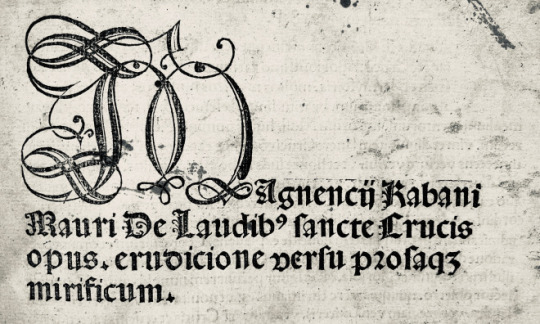
Folio Aa6, Bb4, a-k6, A-B6, C4 (last leaf blank).
THIS COPY LACKING [four leaves] A5 & 6, Bb1 and a1. [two woodcuts of Alcuin interceding on behalf of Rabanus before Pope Gregory iv, and of Rabanus presenting his poems to the Pope; and two figured dedicatory poems the first to Louis the Pious the next christ crucified] It is bound in a full vellum modern binding. First Edition (for a second edition see below)
Types 3:109R, 4:180G; 40 lines of transcribed verse + headline, 40 lines of commentary + headline, red and black printing throughout, calligraphic woodcut initial (Proctor, fig. 24) M on title page, woodcut initials printed in red, and a figured prefatory poem, 28 carmina figurata, the first entirely xylographic, the remaining poems combining printed and xylographic letters with the versus intexti printed in red (except fig. xvi), enclosed by either woodcut figures (of the emperor, Christ, the Evangelists, Cherubim, etc.) printed in black or by Christian symbols and characters, most defined by metal rules in red.
This is a remarkable typographical achievement, probably the earliest attempt to reproduce a medieval manuscript. The greater portion of the work comprises a preface in verse and twenty-eight poems. “Hrabanus Maurus, the abbot of Fulda, wrote in the midst of the ‘new monasticism,’ a period associated with a revival of literacy and learning. In religious and secular spheres. This ‘script culture,’ as Rosamond McKitterick has it, used the written word not only as a mode of communication but as ‘a resource, a guide, a key, and an inspiration,’ especially in the devotional practice of Christianity.

Each of the twenty-eight picture poems that form In honorem sanctae crucis explores a different theme relating to the Cross through a complex interplay of word and image. The poems each have an equal number of letters per line, written continuously like a grid. By following the letters in the usual direction for a Latin text—from left to right, top to bottom—each grid reads as one long poem. But within each grid, certain letters are also marked out with colour and drawings to form pictures. The letters that make up these pictures read as separate short poems embedded within the larger poem. As such, each page of In honorem sanctae crucis presents not just a puzzle of words and pictures, full of hidden and interrelated messages for the reader to decode bout a meditation exercise.
“Hrabanus created the various shapes and figures by highlighting individual letters in underlying poens in colour (in the printed editions red), and theses individual letters together make up meaningful text , ranging from simple declarations to very elaborate ones. For example, Carmina 2 contains a simple cross inside a square (Hrabanus calls it a “tetragonum”)whose sides form a border for the poem as a whole. The textfrom the underlying poen that makes up the figure consists of six hexameters, each one an address to the cross beginning with the words ‘O crux…’ When we follow Hrabanus’s instruction in the accompanying prose text for reading these hexameters, we find the following: even though the verse that forms the top of the square is also the opening of the underlying poem, he insists that we begin reading with the stem of the cross, from top to bottom.” (Schipper)
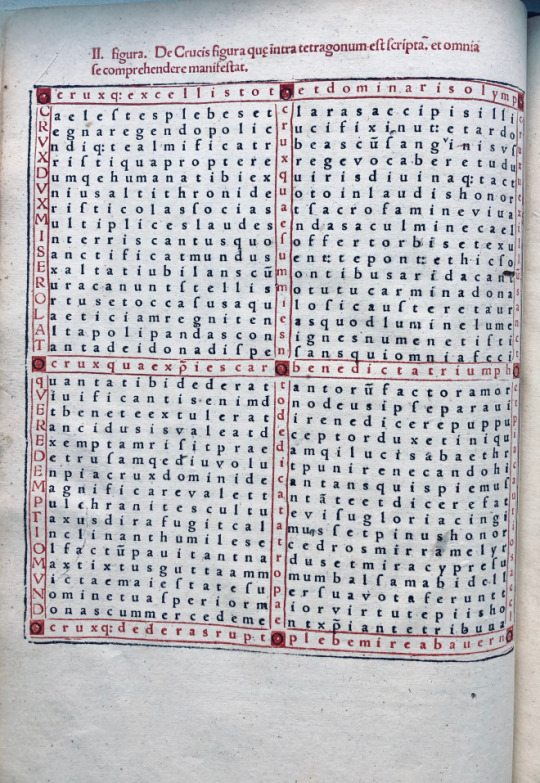
Sunt quoque uersus duo in ipsa ccruceconscripti, quorum prior est:
O CRVX QVAE SVMMI ES NOTO DEDICATA TROPAEO
a summo in ima descendens. Alter uero:
O CRVX QVAE CHRISTI ES CARO BENEDICTA TRIVMPHO
a dextra in sinistram crucis tendens ‡
‡“there are also two verses inscribed in the cross, the first of which is :
“ O cross , thou who art at the height of fame, a dedicated moment”
‘running from the top down. And a second’
“O Cross thou who through the body of Christ art the blessed triumph”
‘running from the right to the left.’
Further more Hrabanus flips left and right the texts point of view alternates , Hrabanus tells us the cross is looking out at the reader, not the other way around. “ Only after we have read the hexameters in the cross are we free to read the verses in the four sides of the tetragon, and even then Hrabanus constrains the order in which they are to be read: first the top, then the bottom, then the right side then finally the left side.”
More complex figures present further challenges in reading. The figure in Carmen 25, for example, consists of eight letters of the word ‘ALLEVIA’ arranged around a small cross. It does not take much effort to notice that we need to start with the A, read down to the E, continue on the left, and end on the right of the figure; and that each time we trace out those letters we make the sign of the cross. It becomes more difficult when we also try and read the text that is enclosed in the figures.

The letters of ALLEVIA are made of the following letters from the underlying poem.
A crux[a
L eter
L na[de
E i]es[lave[v L ivis
V in]arc
I e]po
A lorvm
CRUX AETERNA DEI ES LAVS VIVIS IN ARCE POLORUM
‡ Eternal cross, thou art the praise of God, thou livest in the arc of the skies.

Peter Godman, Poetry of the Carolingian Renaissance (Norman: University of Oklahoma Press, 1985), 249.
A. G. Rigg and G. R. Wieland, ‘A Canterbury Classbook of the Mid-eleventh Century Anglo-Saxon England 4 (1974), 113-30.
William Schipper, ‘Hrabanus Maurus in Anglo-Saxon England: In Honorem Sanctae Crucis’, in Early Medieval Studies in Memory of Patrick Wormald, ed. Stephen Baxter, Catherine Karkov, Janet L. Nelson, David Pelteret (Farnham, Surrey; Burlington, Vt.: Ashgate 2009), 283-98.
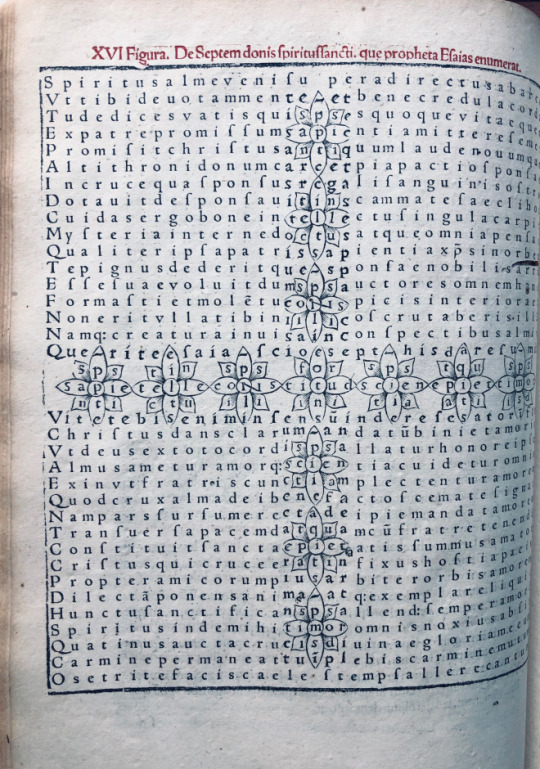
Proctor, R. Index to the early printed books in the British Museum,; 11747; Adams, H.M. Catalogue of books printed on the continent of Europe, 1501-1600, in Cambridge libraries,; R3; Catalogue of a collection of early German books in the library of C. Fairfax Murray,; 350; Panzer, G.W.F. Annales typographici,; VIII 227, 2; Pollard, A.W. Catalogue of books mostly from the presses of the first printers … collected by Rush C. Hawkins,; 189 Panzer, VIII, 227, no. 2. Proctor 11747. Fairfax Murray 350./ Last leaf blank./ Edited by Jakob Wimpheling.–cf. title page verso./ Illustrations: 2 woodcuts of the author presenting his book to the pope, and many woodcut figures (Christ, cherubs, crosses, symbols, etc.) printed on 28 pages of text. Some of the text within and near the outline figures is xylographic, the rest printed. The letters within the outlines are printed in red and may be read separately in a different sense. Printed in red and black, initials (except on t.p.) in red./ With label of Sinclair Hamilton. Peter Godman, Poetry of the Carolingian Renaissance (Norman: University of Oklahoma Press, 1985), 249.
A. G. Rigg and G. R. Wieland, ‘A Canterbury Classbook of the Mid-eleventh Century Anglo-Saxon England 4 (1974), 113-30. William Schipper, ‘Hrabanus Maurus in Anglo-Saxon England: In Honorem Sanctae Crucis’, in Early Medieval Studies in Memory of
Patrick Wormald, ed. Stephen Baxter, Catherine Karkov, Janet L. Nelson, David Pelteret (Farnham, Surrey; Burlington, Vt.: Ashgate,
^)^)^)^(^(^(^
The second edition One-Hundred and three years later.
8). 354J Hrabanus Maurus. 784-856?
Magnencij Rabani Mauri De Laudib[us] sancte Crucis opus. erudicione versu prosaq[ue] mirificum. Cum antiqviate avctoris <annis abhinc prope octingentis abbatis primum fuldensis, archiepiscopi postea moguntini. tum noitate scriptionis memorabile. Qvo figvris sive imaginibvs XXVIII. multi fedei christianae mysteria, multi mystici numeri; angelorum, virtutum, VII. donorum Spiritus Sancti, VIII. Beatitudinum, IV. elementorum, IV. temorum anni, VI euangelistarum & agni, mensium, ventorum, V librorum Moysis, nominis Adam, alleluia, & amen, aliarumq[ue] rerum vis & dignitas in formam crvis reedacta, subtiliter et ingeniose explicantur.
Augustæ Vindelicorvm e typographeo Praetoriano. , 1605. $9,000

Folio Aa6, Bb4, a-k6, a6, B4, c4. (complete). Printers mark on title page, woodcut initials printed in red, two woodcuts of Alcuin interceding on behalf of Rabanus before Pope Gregory iv, and of Rabanus presenting his poems to the Pope; a figured dedicatory poem to Louis the Pious and a figured prefatory poem, 28 carmina figurata, the first entirely xylographic, the remaining poems combining printed and xylographic letters with the versus intexti printed in red (except fig. xvi), enclosed by either woodcut figures (of the emperor, Christ, the Evangelists, Cherubim, etc.) printed in black or by Christian symbols and characters, most defined by metal rules in red. Bound in contemporary deer skin.
This aside from the prologue this edition is a re-set reproduction of the first printed edition (see above)
#######+++++#######
9) 383J Johannes de Anania
Commentaria super prima et secunda parte libri quinti Decretalium. Add: Repertorium
Bologna : Henricus de Colonia, 7 Dec. 1479, 5 Jan. 1480. $17,000
Large folio 422 x 285mm
Pars III (bound first) a8,b6,c10,d6,e8,f4,g8.(lacking a1Blank)
Pars I (bound second) a10,b8,i8,k6,l8,m8,n6,o6,p8,q8,r10s 10.
Pars II (bound third) A8,-F8,G6,H8,-L8,M6,N8,O8P6,Q8,R8,S6,T8,U10,X8-Z8, &8, ¶8,€8,¡8. In three parts, dated: 7 Dec. 1479 (Commentaria, partes I-II); 5 Jan. 1480 (Repertorium)
No copy of parts II & III in the US.
The margin of a2 of the Repertorium cut off with no text loss (see image) This is a very very wide margined copy, with strong and crisp paper. The first leaf is stroked in red and blue. Throughout the rest of the books capital spaces are left blank. This copy is bound in 19th century vellum.
ANANI’A, JOHANNES DE : his family name, Anagni. implies that he was of the family of the Catani, and that his father’s name was Leonardo. He taught canon law in Bologna, and had the reputation of a conscientious man. He studied under Floriano di San Pietro. Alexander Tartagni and Andreas Barbati were his scholars; the former became his step-son, and the latter inherited his library. According to Orlandi, Anania was sent ambassador from the city of Bologna to Pope Martin V. in 1425, and he was also employed to conduct negotiations with other princes. Johannes de Anania at the time of his death, in 1455 or 1458, was archdeacon at Bologna. Spangenberg enumerates four of his works, three of which were published at Lyon between 1521 and 1555 : — 1. A Commentary on the fifth book of the Decretals, published in folio at Lyon in 1521, and reprinted there in 1553. 2. Consilia, discovered and edited by Ludovico Bolognini, in folio, at Lyon in 1555, reprinted at Venice in 1570. 3. “De Revocatione Feudi alienati,” in octavo, at Lyon, in 1546, reprinted at Basle in 1564. 4. A Collection of the Decisions of the Roman Rota, at Venice, in folio, in 1496. Mazzuchelli mentions a treatise on the law as to salaries, “Allegatio de Salario et Stipendio ac de Obligatione et Promissione Domini,” which is preserved in MS. at Bologna in the library of the Collegio di Spagna. In addition to these Lipenius ascribes to Johannes de Anania a legal tract on church patronage, “De Jure Patronatus Ecclesiastico,” published at Amsterdam in 1640; and a collection of cases (” Quaestiones”) at Cologne in 1570. To the folio edition of Baldus, “In Usus Feudorum Commentaria,”

published at Lyon in 1550, there is appended a thesis on the law regarding the alienation of fiefs, maintained by Johannes de Anania at a public disputation in Bologna. The date is not given, but he is styled “Doctor et Canonicus,” and his opponent is said to have been Secundinus de Natis; and the publisher intimates that the MS. had been preserved in the library of Johannes Nevizanus at Asti. No. 446. of the Arundel MSS. in the library of the British Museum contains a treatise “De Usuris” by Johannes de Anania. The volume is of a large folio form, and the ” De Usuris,” written in a small character with numerous contractions, occupies the folios 93. to 164. inclusive, each folio containing four columns. These treatises are the only compositions of the author we have seen, and they leave a favourable impression of his skill in selecting authorities to support and elucidate his positions, and of his talent for lucid arrangement. (Mazzuchelli, Scrittori d’ Italia; Spangenberg, in Ersch und Gruber’s Allgemeine Encyclopadie; Alidosi, Appendice alli Dottori Bolognesi de Legge Canonica e Civile; Orlandi, Notizie degli Scrittori Bolognesi; Baldus Perusinus, in Usus Feudorum Commentaria doctissima, quibus accesserunt Andr. Siculi Adnotationes una cum Joan. de Anania eleganti Disputatione in tres secta Quastiones, Lugduni, 1550, fol.; Arundel MSS. in the British Museum, No. 446.) W. W
Not in Goff: ISTC ij00250150; H 938*; Torchet 521; IGI 5245; IBE 3188; Kotvan 702; Sajó-Soltész 1881; Martín Abad J-44; Voull(B) 2735,20; Walsh 3188; BSB-Ink I-365; GW M12841
Holdings: United States Harvard University, Law School Library (I) only.

)0(
)0(
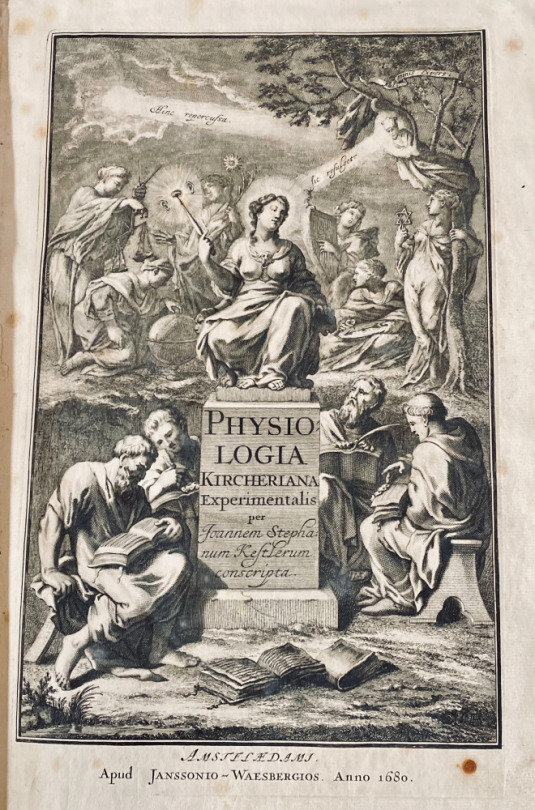
10) 381J Athanasius Kircher 1602-1680
Physiologia Kircheriana Experimentalis, Qua Summa Argumentorum Multitudine & Varietate Naturalium rerum scientia per experimenta Physica, Mathematica, Medica, Chymica, Musica, Magnetica, Mechanica comprobatur atque stabilitur. Quam Ex Vastis Operibus Adm. Revdi. P. Athanasii Kircheri extraxit, & in hunc ordinem per classes redegit Romæ, Anno M. DC. LXXV. Joannes Stephanus Kestlerus Alsata, Authoris discipulus, & in re litterariâ assecla, & coadjutor.
Amsterdam: Ex Officinâ Janssonio-Waesbergiana. Anno 1680 $9,500
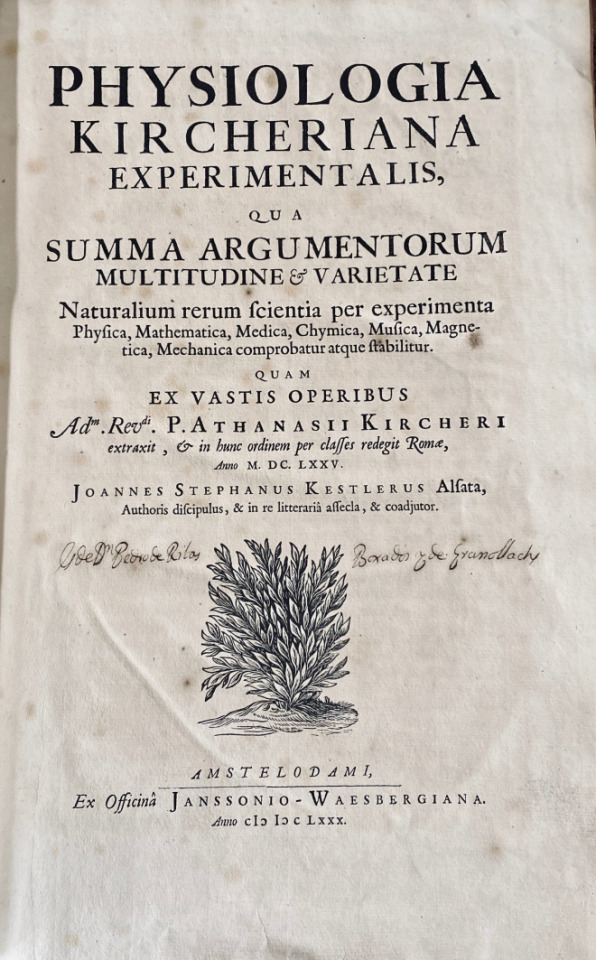
Folio. 15 x 9 3/4 inches. *4, A-Z4, Aa-Ii4. First edition.mmThis copy is quite clean and crisp throughout, never having been washed or pressed. There is some occasional spotting and browning. but none is too extensive. The binding is twentyth century full vellum with title on spine. an impressive and large copy!
“Thus in the must varied branches of science Kircher played the role of pioneer. Even medicine received his attention, as is shown for example by his treatise, ‘Scrutinium phyisco-medicum contagiosæ luis, quæ pestis dicitur’ (Rome, 1663). His scientific activities brought him into scientific correspondence with scholars laboring in the most different fields, as the numerous volumes of his extant letters show. It is to his inventive mind that we owe one of the earliest of our counting machines: the speaking-tube and æolian harp were perfected by him. He was also the inventor of the magic lantern which has since been brought to such perfection and is and is today almost indispensable. [All of these devices are illustrated in the present work, compiled in the year of the author’s death by Kircher and his student Johann Stephan Kestler, including three large and striking engravings of magic lanterns.]”
May I ask the reader to take the following quote with a measure of indulgence for its closed minded author [circa 1913] with the hope that modern folk of the last decade of the second millennium have a bit more tolerance for the many sciences that we have yet to master.
“That the most varied judgments should be formed and expressed on a man of such encyclopædic knowledge was only to be expected. He tried to find a grain of truth even in the false sciences of alchemy, astrology, and horoscopy, which were still in his time much in vogue, nor is it surprising that in the province of astronomy he did not at this early date defend the Copernican System.” (the above two quoted taken from the Catholic Encyclopedia, vol. viii, page 662) Kircher was an accomplished and versatile scholar who applied his intellectual abilities to a myriad of scientific problems. This work is a fascinating compendium of scientific experiments and principles which documents the accomplishments of early modern thinkers of the west.
^)^)^)^(^(^(^
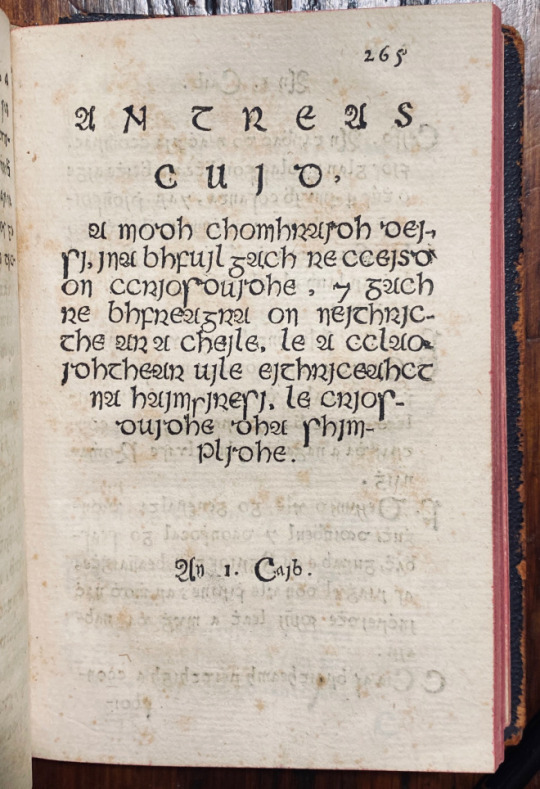
11) 380J Francis Molloy. fl 1660
Lucerna fidelium, seu, Fasciculus decerptus ab authoribus magis versatis, qui tractarunt de doctrina Christiana : divisus in tres partes.
Romæ : Typis Sacræ Congreg. de Propaganda Fide, M DC LXXVI [1676] $4,500
Octavo 6 X 4 inches : A-2B8 2C2. complet, signature ) is mis-signed . This copy is bound in early 20th century sheep.

MOLLOY or O’MAOLMHUAIDH, FRANCIS (Jl. 1660), theologian and grammarian, was a native of the county of Meath, Ireland. The family of which he was a member had extensive landed possessions in the district known as O’Molloys’ Country, and some of them engaged actively in the Irish movements from 1641 to 1652.
Francis Molloy entered the order of St. Francis, became a priest, was appointed professor of theology at St. Isidore’s College, Rome, and acted as agent for the Irish catholics at the papal court in the reign of Charles II. His first published work was entitled ‘Tractatus de Incarnatione ad mentern Scoti,’ 1645. This was followed in 1658 by ‘ Jubilatia genethliaca
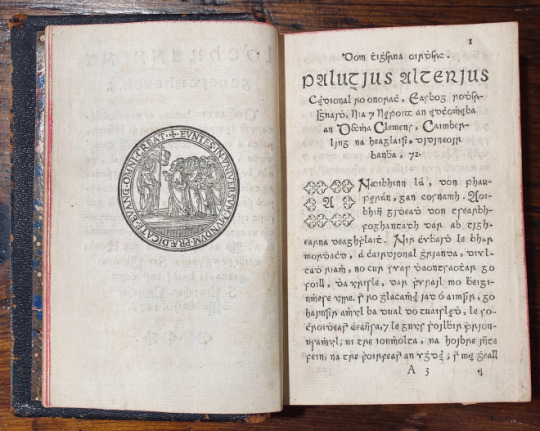
in honorem Prosperi Balthasaris Philippi, Hispani principis, carmine,’ and by a Latin treatise on theology in 1666.
A catechism of the doctrines of the catholic church in the Irish language was published by Molloy in 1676 with the title: ‘Lucerna tidelium, seu fasciculus decerptus ab authoribus magis versatis qui tractarunt de doctrina Christiana.’ It was printed at Rome at the press of the Congregation ‘de propaganda fide,’ ( This book is the first book they printed in Irish Type) from which, in 1677, issued another book by Molloy, entitled ‘Grammatica Latino-Hibernica,’ 12mo, the first printed grammar of the Irish language.
Edward Lhuyd [q. v.], in his’ Archaeologia Britannica,’published at Oxford in 1707, mentioned that he had seen a manuscript grammar of the Irish language copied at Louvain in 1669 which partially corresponded with that of Molloy. He added that Molloy’s grammar, although the most complete exta’nt in his time, was deficient as to syntax and the variation of the nouns and verbs. The date of Molloy’s death has not been ascertained.
In 1626 Propaganda Fide had installed a printing press for the foreign missions and not much later another one was brought to Louvain where books and catechisms were printed for both the local college and the Irish mission.* The problem with the Propaganda printing press was that only books in Latin and Italian were allowed to be printed so it took until 1674 when Francis Molloy asked for permission to print a catechism there in Irish with the explanation “che altra malamente capisce e vacilla assai per mancanza d’intruttore e d’intruttion sana.”**.
[“Irish priests at Rome had a new Irish type cut about 1675 … [this was] their first book.”- -H. Reichner, Catalogue 34, Jan. 1968]
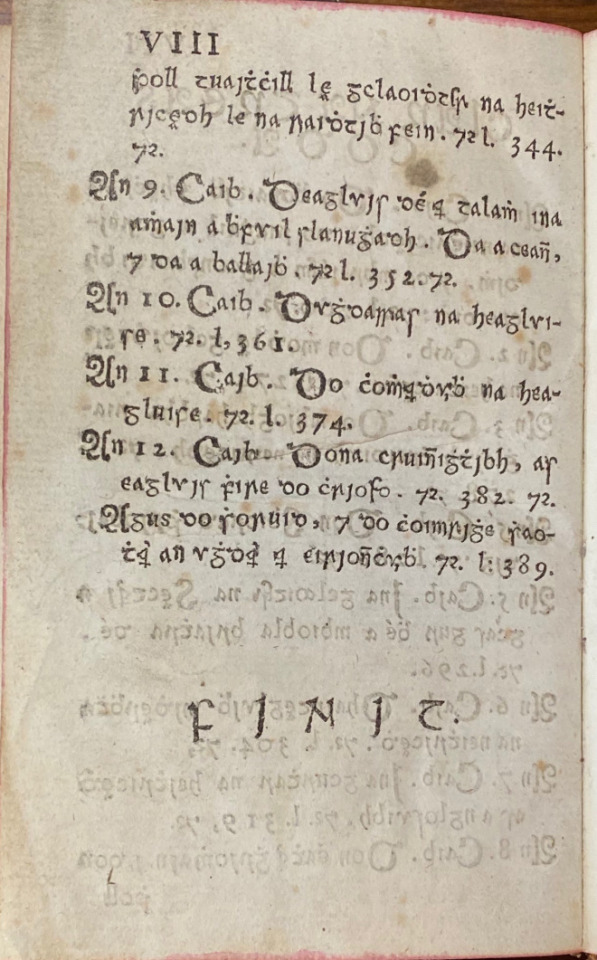
Wing O291C, English short title catalogue,; R41480; Clancy, T.H. English Catholic books, 1641-1700 (rev. ed.),; entry 743; Catalogue of seventeenth century Italian books in the British Library,; page 628
*& ** ;Egan, Bartholomew (ed.): Notes on Propaganda Fide Printing Press and Correspondence concerning Francis Molloy O.F.M., in: Collectanea Hibernica, No. 2 (1959), pp. 115-124.
)0(
)0()0(
With a reference to the invention of printing on the verso of Folio 64.
12) 359J Werner Rolewinck 1425-1502
Fasciculus temporu[m] omnes antiquo[rum] chronicas strictim complectens felici numine incipit. Prologus.
Venice : Erhard Ratdolt, 8 Sept. 1485 $16,000
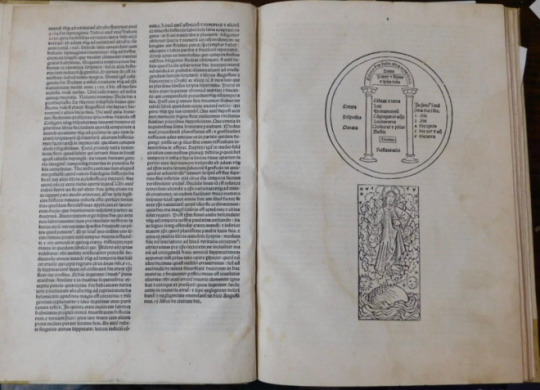
Folio (275 x 195 mm). [A]8 [a-g]8 [h]10 75 leaves without signatures or page numbers (9 leaves, 1-66 foliated ), 3 columns in table, 59 lines and foliation, gothic letter, 2 large ornamental initials, 59 woodcuts, one full-page, woodcut diagram. Fifth and last Venetian edition, and fourth Ratdolt edition being the most complete edition of Rolewinck s chronological history of the world. The chronology follows a double time-line, measuring time from both the Creation and the birth of Christ to the death of the Ottoman Sultan Mehmed II commonly known as Mehmed the Conqueror in the year 1481, demanding a
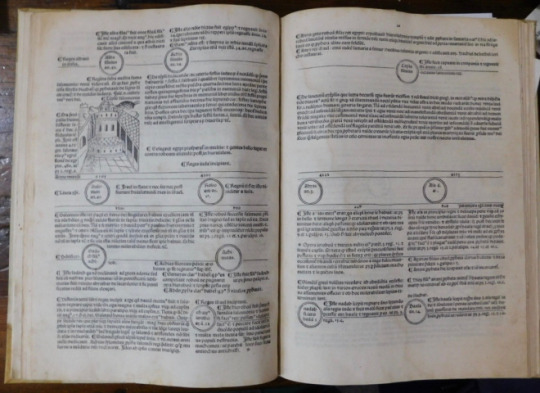
remarkably complex typographical layout. The Fasciculus Temporum (Little bundles of time) was the first book printed on history of the world, it is also one of the earliest and greatest of illustrated incunabula. The illustrations show Noah s Ark, the tower of Babel and contain many town views including Jerusalem, Syracuse, Rome and the Doge s Palace in Venice.
Rolewinck (1425-1502) was a Carthusian monk and prolific author. This book was both the most popular of his numerous writings and the most popular concise world chronicle of its time, being printed 32 times in the 15th century, including translations into French, German and Dutch . Rolewinck’s Fasciculus Temporum was an enormously popular world chronicle, appearing in over 30 incunabular editions in Latin, German, French, and Dutch. A very handsome and typographically-sophisticated volume, with varying columns, circular devices with inset type, and woodcuts throughout.
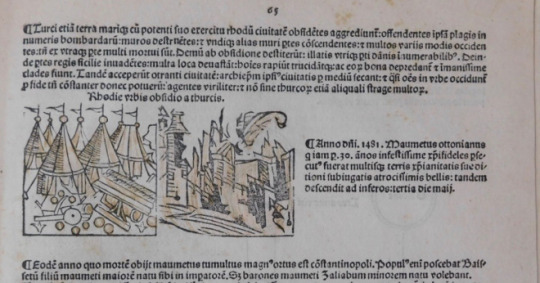
This work aspires to trace the history of the world from the beginning of time until the year of pulication. The thirty-three woodcuts are crisp and rather charming, and, like those in many fifteenth- and sixteenth-century chronicles, are occasionally reused to illustrate different events and locations. The work is fascinating for the comprehensiveness of its content as well as the beauty of its execution.
Of particular interest is a reference to the invention of printing (in 1454) on the verso of Folio 64.

Goff R271; GW M38738; ; BMC V 290; H 6935*; Redgr 52; Essling 280; Sander 6530; Schr 5116C; Pell Ms 10192 (9969); CIBN R-177; Arnoult 1276; Neveu 528; Nice 269; Torchet 821; Polain(B) 4691; IDL 3943; IBE 4955; IGI 8420; CCIR R-40; Kotvan 1024; Sajó-Soltész 2972; Gspan-Badalić 590; IBPort 1576; Mendes 1124, 1125, 1126; Madsen 3526; Martín Abad R-48; Voull(B) 3801; Hubay(Augsburg) 1811; Hubay(Eichstätt) 898; Walsh 1830; Rhodes(Oxford Colleges) 1525; Bod-inc R-121; Sheppard 3688; Pr 4404; BSB-Ink R-247
#######+++++#######
13) 367J Petrus de Rosenheim. (1380-1432). Nom probable : Petrus Wiechs
[Roseum memoriale divinorum eloquiorum]
[Köln] : [Southern Germany : n.pr., about 1480-90?]
or [Cologne? : n.pr., about 1483] or [Ludwig von Renchen?], 1483.
$12,000

Quarto (190 x 155 mm). Collation: a-f8 [1-68]. [48] leaves. First Edition. Text in one column, 32 lines. Type: 80G. Initials painted in red, and blue ink throughout. Simple vellum binding from a 15th century vellum leaf. Gothic script. . A very good copy, old repair to the first blank leaf, a few spots, pale stain at the lower blank corner of the first quires. It is not known where and by which press this edition was printed. ISTC gives Southern Germany and a date of c.1480-1490, GW tentatively suggests Oberrhein, 1483, and Proctor attributes it to Ludwig Von Renchen in Cologne.
The hexameters of each section of the summary form an acrostic of the letters of the alphabet. (alphabetarium) as to insure memorization in the proper sequence, the first word of each verse falls neatly into alphabetical order. [1,194 short mnemonic verses] It uses characteristic couplets (distiches) to express the main content of all chapters of the Old and New Testament. This introduction makes it possible to easily find every quote in the Bible.
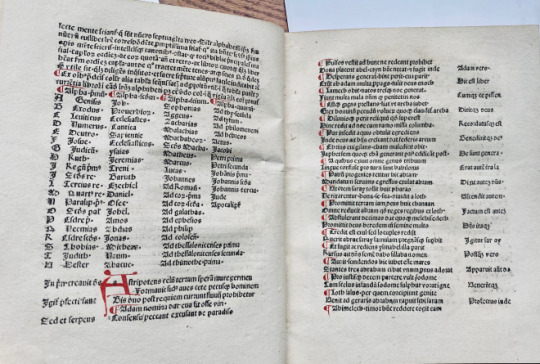
A significant record of the essential role of memory in late-medieval piety, One of the earliest printed books on the ars memorativa or mnemotechnic was composed by the German Benedictine monk Petrus of Rosenhaym (Upper Bavaria), written between 1423 and 1426 for Cardinal Giulio Branda di Castiglione. Petrus of Rosenhaym composed numerous treatises, sermons, and verses: the Roseum memoriale is surely his most famous work, enjoying wide popularity during the fifteenth century and first half of the sixteenth century. The mnemotechnic method here employed is extremely complex: the hexameters of each section of the summary form an acrostic of the letters of the alphabet. in. A highly popular and broadly used manual, its copies could be found in almost every European church after the invention of the printing press it was printed in several different locations. This early medieval incunable has not been clearly dated| researchers attribute it to the Upper Rhine region sometime between 1480 and 1483. After studying at the University of Vienna, Petrus de Rosenhaym, along with his friend Nikolaus Seyringer, moved to Subiaco, where he entered the Benedectine order. In 1413, he was appointed prior to the cloister of Rocca di Mondragone near Capua. In 1416, he took part in the Council of Konstanz, and later he was prior in Melk (Lower Austria). After 1423, he was appointed ‘cursor biblicus’ and ‘magister studentium’.
Goff R336; BMC I 312; ; GW M32724; ISTC; ir00336000; Polain(B) 3128; IBE 4559; IGI 7668; IBP 4380; Sajó-Soltész 2676; Madsen 3549; Borm 2134; Hubay(Würzburg) 1704; AmBCat 199; Walsh 492; Oates 867; Pr 1517;; BSB P-362; Van der Haegen II,2:16,4?; Young 278;.
Copies in the United States of America: Brown, Harvard, Library of Congress, Huntington, The Newberry Library, Yale
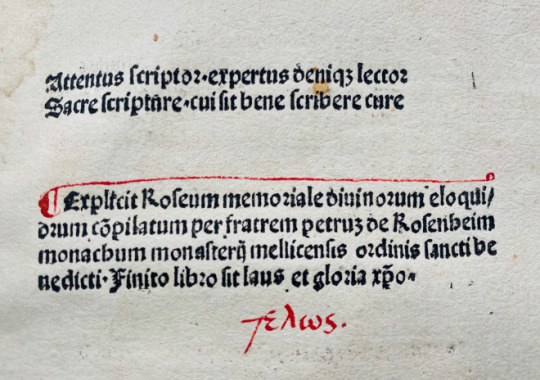
^)^)^)^(^(^(^
^)^)^)^(^(^(^

14) 384J Raymundus de Sabunde -1436
Theologia naturalis, sive, Liber creaturarum : specialiter de homine et de natura eius inquantum homo, et de his que sunt ei necessaria ad cognoscendum seipsum [et] deum et omne debitu[m] ad quod homo tenetur et obligat[ur] tam deo quam p[ro]ximo.
Straßburg: Martin Flach, 21 January 1496. $17,000
Imp[re]ssus Argentine per Martinum Flach inibi co[n]ciuem anno incarnat[i]o[n]is d[omi]nice Millesimoq[ua]dringentesimononagesimosexto men[sis] v[er]o Ianuarij die vicesimop[ri]mo
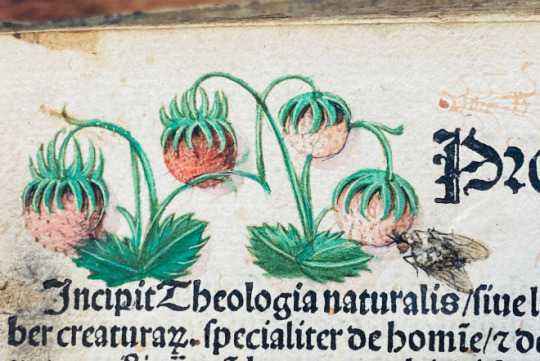
Folio (280 x 200mm.) π6 a8 b-y6 z8 [et]6 [con]8 (the last leaf supplied from another copy, printed on recto only), The second leaf (π2) has a beautiful a green painted initial A [Amor] on a gold ground with pink and blue edges, extending into the margins with green-stemmed pink and gold flowers on opposite side. The first leaf of the text proper (a1) Has a large blue painted initial A on a gold ground with pink and green edges, large pink and purple flowers, strawberries thistles and a Tromp l’oeil of a Dead fly,( quite charming) fill uppermargin; 3-line initials in alternating red and blue, rubricated throughout. This is the first dated edition.
It is bound in Contemporary deerskin over wooden boards, covers panelled and tooled in blind with repeated small rosette tool, remains of paper labels on spine (lacking metal furniture and clasps, some wear and small areas of loss). This copy has some contemporary manuscript notes, including a two-line note on f. b2recto, and on f.a2verso is a marginal drawing of the scala naturae with the four gradus marked.
Provenance: Contemporary inscription of Johannes Pengl (Penngl) from Weißenburg in Bavaria, who was active in Eichstätt & Vienna, with a note of cost of binding on final paste down. Later notes and shelf-mark on front paste-down and loose sheet.
Colophon: Finit liber creatura[rum] seu nature siue nature siue de ho[m]i[n]e p[ro]pt[er] que[m] alie creature facte su[n]t ex cui[us] cognit[i]one illu[m]inat[ur] ho[mo] i[n] [co]gnit[i]o[n]e dei [et] creaturarum.
This text marks the dawn of a knowledge based on Scripture and REASON.
The Catholic Encyclopedia sees this as “It represents a phase of decadent Scholasticism, and is a defense of a point of view which is subversive of the fundamental principle of the Scholastic method. The Schoolmen of the thirteenth century, while holding that there can be no contradiction between theology and philosophy, maintain that the two sciences are distinct. Raymond breaks down the distinction by teaching a kind of theosophy, the doctrine, namely that, as man is a connecting link between the natural and the supernatural, it is possible by a study of human nature to arrive at a knowledge even of the most profound mysteries of Faith. The tendency of his thought is similar to that of the rationalistic theosophy of Raymond Lully….Moreover, in Spain scholastics, in combating Islam, borrowed the weapons of their erudite antagonists. Close internal resemblance indicates that Raimund de Sabunde was preceded in method and object by Raymund Lully.” CE

What is new and epoch-making is not the material but the method; not of circumscribing religion within the limits of reason, but, by logical collation, of elevating the same upon the basis of natural truth to a science accessible and convincing to all. He recognizes two sources of (1)knowledge, the book of nature and (2) the Bible. The first is universal and direct, the other serves partly to instruct man the better to understand nature, and partly to reveal new truths, not accessible to the natural understanding, but once revealed by God made apprehensible by natural reason. The book of nature, the contents of which are manifested through sense experience and self-consciousness, can no more be falsified than the Bible and may serve as an exhaustive source of knowledge; but through the fall of man it was rendered obscure, so that it became incapable of guiding to the real wisdom of salvation. However, the Bible as well as illumination from above, not in conflict with nature, enables one to reach the correct explanation and application of natural things and self. Hence, his book of nature as a human supplement to the divine Word is to be the basic knowledge of man, because it subtends the doctrines of Scripture with the immovable foundations of self-knowledge, and therefore plants the revealed truths upon the rational ground of universal human perception, internal and external.
The first part presents analytically the facts of nature in ascending scale to man, the
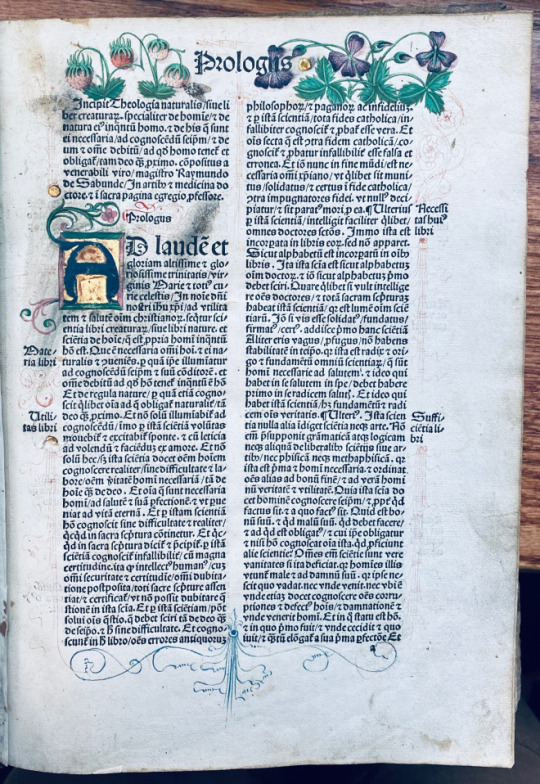
climax; the second, the harmonization of these with Christian doctrine and their fulfillment in the same. Nature in its. four stages of mere being, mere life, sensible consciousness, and self-consciousness, is crowned by man, who is not only the microcosm but the image of God. Nature points toward a supernatural creator possessing in himself in perfection all properties of the things created out of nothing (the cornerstone of natural theology ever after). Foremost is the ontological argument of Ansehn, followed by the physico-theological, psychological, and moral. He demonstrates the Trinity by analogy from rational grounds, and finally ascribes to man in view of his conscious elevation over things a spontaneous gratitude to God. Love is transformed into the object of its affection; and love to God brings man, and with him the universe estranged by sin, into harmony and unity with him. In this he betrays his mystical antecedents. Proceeding in the second part from this general postulation to its results for positive Christianity, he finds justified by reason all the historic facts of revealed religion, such as the person and works of Christ, as well as the infallibility of the Church and the Scriptures; and the necessity by rational proof of all the sacraments and practices of the Church and of the pope. It should be added that Raimund’s analysis of nature and self-knowledge is not thoroughgoing and his application is far from consistent. He does not transplant himself to the standpoint of the unbeliever, but rather executes an apology on the part of a consciousness already Christian, thus assuming conclusions in advance that should grow only out of his premises. Yet his is a long step from the barren speculation of scholasticism, and marks the dawn of a knowledge based on Scripture and reason.
In its day, and for a long time later, it was a celebrated text. The title translates ‘Natural Theology or the book of [living] creatures, in particular about man and his nature inso far as he is man, and about those things necessary for him to know both himself and God, and about every duty by which man is held and obligated both in respect of God and his neighbour.’ The scope is therefore pretty wide. The main point of Sebond’s work is that that faith can be taught, attained, understood by natural reason and not simply on the basis of blind faith and literal adherence to Scripture, although this last is given full weight as is the teaching of ‘sacrosancta romana ecclesia who is the mother of all faithful christians, mistress of grace and faith and rule of truth…’ (preface on a2ra). The work is divided into 330 ‘tituli’ or chapters beginning with the origins of natural theology and ending with the last judgement, the subjects treated at greatest length being ‘God’ and ‘Man’.
Theologia Naturalis, which circulated widely in manuscript and is known particularly in a manuscript in Toulouse (747) corrected after the author’s own copy, was first published in what is called the ‘third family’ in Deventer in 1484-85 (possibly through the offices of the Brothers of the Common Life; the Bodleian copy is from their house at Doesburg, Holland), and then Lyon ca. 1488 from the printer Balsarin. This Flach printing circulated widely (a copy was at Winchcomb abbey in Gloucestershire within a few years (now in Glasgow) and early in the 16the century Archbishop Warham (Abp. 1503-32 ) gave a copy to All Souls College, Oxford) and is the first dated edition. There were a number of later editions (including another Flach edition of 1501) right up into the 17th century. Indeed the well-known 17th-century philosopher Kenelm Digby ( 1603-1664) had a copy of this edition (now at Durham University Library at Bamburgh Castle). Part of the Theologia (Dialogos de la naturaleza delhombre) was translated into Spanish and printed in Madrid in 1610 and 1616, and a resumé by the Carthusian Petrus Dorlandus (Viola anime per modum dyalogi) was published in Cologne in 1499 (ISTC id00360000 ) and in Toulouse in 1500 I(ISTC id003610000).. The Theologia because of the importance it accorded human reason did not escape the notice of the holy Office and was placed on the Index in the middle of the 16th century. Montaigne indeed discovered this during his visit to Rome.
Goff R33.; BMC I, 154.; HC 14069*; GW M36911; Bod-inc R-018. ISTC ir00033000. Palau 283900
◊
◊ ◊
◊

15) 369J Publius Terentius Afer. 185-
Terentius Comico Carmine
Impressum in nobili Helvecior[um] urbe Arge[n]tina : Per Ioanne[m] Grüninger mira etium arte ac diligentia. 1503 $7,500
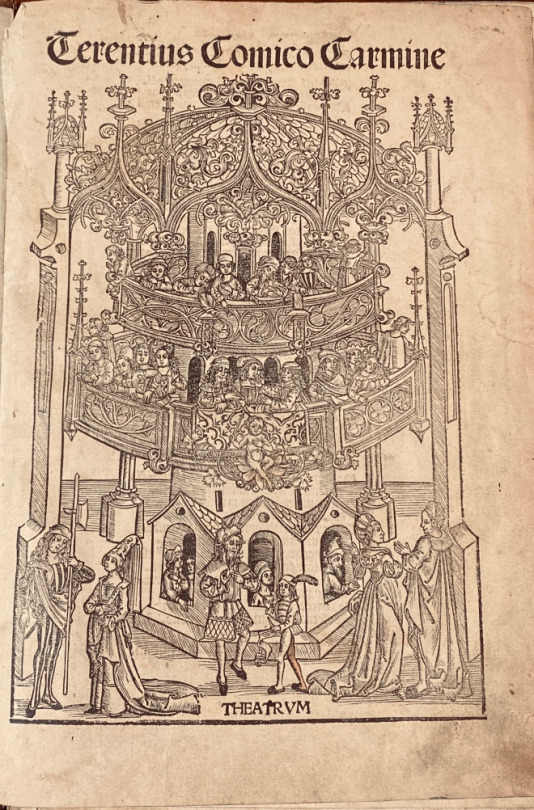
Folio A6 B8 C-Z6 AA6 Bb4 Cc6. There are numerous handwritten annotations in ink (marginal and interlinear, ff. IX-XIX). The binding of half-calf with corners of the XIXth, back with 4 sewing support with pieces of title of red and green leather, boards covered with stony marbled paper. { A typical Kloss binding} (there is a tear sig. B1, with loss; first signature cut shorter at the lower margin; restorations of paper with the last sheets in the upper margin; Yet this copy remains a beautiful illustrated edition of the comedies of Terence with comments by Aelius Donatus and Calphurnius. From the presses of the famous and prolific Strasbourg printer-publisher Johann Reinhard, known as Grüninger, it is remarkably illustrated with 7 large full-page woods (including the famous representation of a theater on the title),

woodcuts depicting the dramatis personae in a land- or cityscape, one at the beginning of each play, and 142 woods in the text 19 of the cuts appear here for the first time; the others are from the 1496 ed. «Grüninger’s illustrations, intended to clarify the complexities of Terence’s plots for the reader, act as visual mnemonic devices for the book’s anticipated student audience. This is demonstrated especially in the full-page woodcut that begins each play, where all of the characters are displayed with connecting lines to indicate their interrelationships. covered with stony marbled paper. { A typical Kloss binding} (there is a tear sig. B1, with loss; first signature cut shorter at the lower margin; restorations of paper with the last sheets in the upper margin; Yet this copy remains a beautiful illustrated edition of the comedies of Terence with comments by Aelius Donatus and Calphurnius. From the presses of the famous and prolific Strasbourg printer-publisher Johann Reinhard, known as Grüninger, it is remarkably illustrated with 7 large full-page woods (including the famous representation of a theater on the title), woodcuts depicting the dramatis personae in a land- or cityscape, one at the beginning of each play, and 142 woods in the text 19 of the cuts appear here for the first time; the others are from the 1496 ed.

«Grüninger’s illustrations, intended to clarify the complexities of Terence’s plots for the reader, act as visual mnemonic devices for the book’s anticipated student audience. This is demonstrated especially in the full-page woodcut that begins each play, where all of the characters are displayed with connecting lines to indicate their interrelationships. A verbal explanation and plot summary accompanies each of these illustrations. The most remarkable feature of Grüninger’s Terence is his use of small interchangeable woodcuts that were combined to create the individual scene illustrations for each play. Individual blocks were cut for most of the characters of the six plays, who are identified by name in overhead banners. The blocks were cleverly combined repeatedly in groups of two to five, sometimes together with cuts of trees and buildings, to create the illustrations. Grüninger was attempting to use the woodcuts as repeatable and combinable objects, much in the same manner as movable type» (Christine Ruggere, in Vision of a Collector: The Lessing J. Rosenwald Collection in the Library of Congress)

Terence writes in a simple conversational Latin, pleasant and direct. Due to his clear and entertaining language, Terence’s works were heavily used by monasteries and convents during the Middle Ages and The Renaissance. Scribes often learned Latin through the meticulous copying of Terence’s texts. Priests and nuns often learned to speak Latin through reenactment of Terence’s plays, thereby learning both Latin and Gregorian chants. Although Terence’s plays often dealt with pagan material, the quality of his language promoted the copying and preserving of his text by the church. The preservation of Terence through the church enabled his work to influence much of later Western drama. [Holloway, Julia Bolton (1993). Sweet New Style: Brunetto Latino, Dante Alighieri, Geoffrey Chaucer, Essays, 1981-2005.]
This copy has the book plate and a binding typical for Kloss. It is NOT Melanchthon’s copy, or his notes!
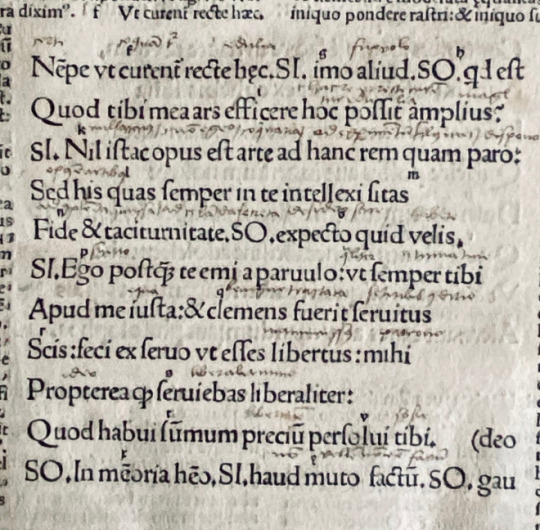
Georg Franz Burkhard Kloss (31 July 1787 Frankfurt am Main – 10 February 1854 Frankfurt). Kloss was the son of a physician and studied medicine at Heidelberg and Göttingen, where he became one of the cofounders of the Corps Hannovera Göttingen. He practiced medicine in Frankfurt. He became a book collector, and gathered a fine collection of old manuscripts,. On February 21, 1838, New York book auction house Cooley & Bangs began a three day sale during which they offered more than 313 incunabula distributed among 1,302 lots. Many incunables came from the collection of George Kloss and had appeared in the London sale of his books three years before. It is entirely possible that the 1838 sale was the first time in America that so many incunables were offered all at once in a single auction..
The bulk of the Kloss books were sold by Sotheby in 1835. Most of the books containing notes were attributed as owned and annotated by Melanchthon .
Catalogue of the library of Dr. Kloss of Franckfort a. M. including many original and unpublished manuscripts, and printed books with ms. annotations, by Philip Melancthon …Which will be sold by auction, by Mr. Sotheby and son … May 7th, and nineteen following days (Sundays excepted) .
https://babel.hathitrust.org/cgi/pt?id=hvd.32044055066971&view=1up&seq=9
Adams D 304. Proctor 9889. Ritter 2284.


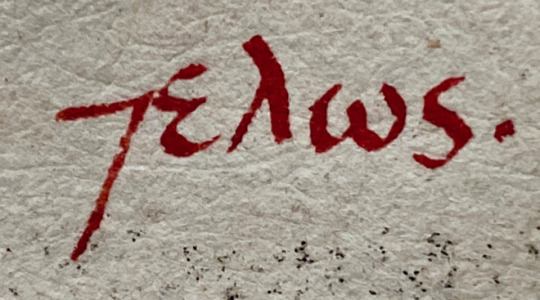
Fascicule XXI. Media Plaga 3-4/2020 Only a day or two ago I was notified that I was in contact with some people tested for and found positive for Covid-19, this came as nothing un expected, I was in contact with hundreds of people many from Europe recently.
#early printed books#fascicule XXI#George Kloss#illustrated incunabulum#Incunabula#Irish authors#irish/gaelic printing#Kircher#Not in Goff#rare book catalogue
9 notes
·
View notes
Video
youtube
ZTT, the label which house Frankie Goes To Hollywood and Propaganda, was also the 80's home of Grace Jones, who is one of those people that achieved so much she's taken for granted. While she is known for her endeavours in many other fields, one must not forget she is also an incredible musician. To be honest, I think she's severely underappreciated, even though her 80's discs are fabulous. Her LP that was produced by Trevor Horn, for instance, Slave To The Rhythm is basically a collection of different variations of the title song. O.K., that does not describe it correctly, it's not a remix album, because it is one of those records that must be heard. It contains a wild concept that is paired with sonic ingenuity and it also serves as a great entry point for Mrs. Jones.
#grace jones#slave to the rhythm#slave to the rhythm song#j.j. belle#david gilmour#luis jardim#richard niles#frank ricotti#andrew richards#bruce woolley#simon darlow#guy barker#stephen lipson#trevor horn#80's music#pop music
1 note
·
View note
Text
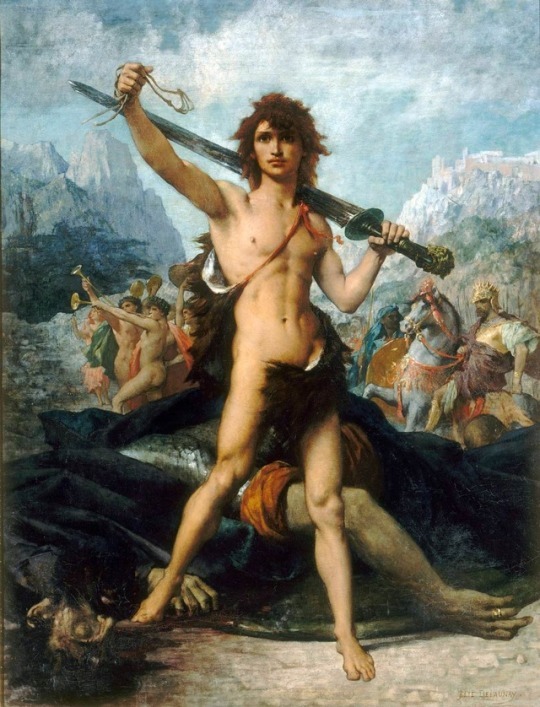
ARTEM, ARCHITECTURA, ET ORNAMENTUM (Latin: Art, Architecture & Decor) DISPLAYING THE HEART OF THE MASCULINE SOUL!
Delauney, Jules-Elie, "David Triomphant," 1874.
The Male Form... In Photography, Art, Architecture, Decor, Style, And Culture Which Moves Beyond Mere Appearance To Reveal The... SOUL.
By LadNKilt: Earl Of Darlow, Ben
Official Residence: County Antrim Northern Ireland; Main Residence: London U.K.; Second Residence: Kansas City Missouri U.S.A.
LadNKilt Archive | Message Me | Submit | LadNKiltLife (Biography)
9 notes
·
View notes
Text
Road to Perdition (2002) Review
Road to Perdition (2002) Review
When Michael Sullivan Jr witnesses a murder he ends up on the road with his mob father Michael Sullivan. This was never going to be easy and they are pushed to the limits.
⭐️⭐️⭐️⭐️
(more…)
View On WordPress
#2002#Brendan McKinney#Ciaran Hinds#Craig Spidle#Crime#Daniel Craig#David Darlow#Drama#Dylan Baker#Graphic Novel#Harry Groener#Ian Barford#Jackie Moran#Jennifer Jason Leigh#John Judd#John M. Williams#Jude Law#Kathleen Keane#Kevin Chamberlin#Kieran O’Hare#Lara Phillips#Liam Aiken#Max Allan Collins#Nicolas Cade#Paul Newman#Paul Turner#Review#Richard Piers Rayner#Road to Perdition#Rob Maxey
0 notes
Text
Road to Perdition - První úspěšný film režiséra posledních dvou bondovek!
Malý Mike Sullivan náhodou u svého táty zahlédne pistoli. Do té doby on ani jeho mladší bráška netuší, čím si vlastně jejich táta vydělává. Rozhodne se to tedy vypátrat. Jeho zvědavost má však katastrofální následky. Táta (Tom Hanks) je totiž poměrně úspěšný gangster a pracuje pro místního mafiánského bosse Johna Rooneyho (Paul Newman). Za zápletkou filmu stojí celkem…- Více na https://www.kritiky.cz/filmove-recenze/retro-filmove-recenze/2019/road-to-perdition-prvni-uspesny-film-rezisera-poslednich-dvou-bondovek/
#Retro filmové recenze#Christian Stolte#Ciarán Hinds#Daniel Craig#David Darlow#Doug Spinuzza#Dylan Baker#Harry Groener#Ian Barford#James Greene#Jennifer Jason Leigh#Jude Law#Keith Kupferer#Kevin Chamberlin#Kurt Naebig#Lara Phillips#Liam Aiken#Michael Sassone#Paul Newman#Sam Mendes#Stanley Tucci#Tom Hanks#Tyler Hoechlin
0 notes
Text
TOYAH ON BBC RADIO MANCHESTER WITH MIKE SWEENEY 1.9.2021

MIKE: The first time I interviewed you was in 1981. You're still performing, still writing, still recording. And it always fascinates me when people have got that longevity. Where does that energy come from and that commitment?
TOYAH: I've got the best job in the world. It's as simple as that. To be in front of an audience. To affect people in a really positive way, with music or acting. It's absolutely wonderful. And I suppose part of me I'm still ambitious because I'm hoping to be discovered.
MIKE: Yes, where I've watched you - you and Robert Fripp. For those who don't know - Robert was in King Crimson. He and Toyah have been doing these lockdown concerts from their kitchen -
TOYAH: Sunday lunches. Yeah.
MIKE: Tell me how that came about? Because that's like watching a kid perform and that’s what you look like
TOYAH: Yeah, well, it's all from our kitchen. In May of last year, I wanted him to move more. So I started to teach him to dance and we posted a 29 second clip of him jiving really badly, but beautifully at the same time. He was just so cute. And within five minutes we had 100,000 replies from around the world as far as New Zealand, as far as Hong Kong, Bali. And we kept posting, and these messages were coming back, just saying thank you, we've cheered them up. By January of this year we had 40 million viewers, and it escalated in a really wonderful way.
And it taught us so much about what a world audience is. And it's not about us showing off as rock stars or saying "look at our cars, look at our swimming pool". It was us saying that we behave badly in our kitchens as well. And it was cheering people up and then I got the record deal in lockdown. Started writing “Posh Pop” with my co-writer Simon Darlow. Robert agreed to come on it.
And we found that we were hugely influenced by knowing this world audience and what they needed. And it wasn't that they were needy people, they just needed to be seen and to be recognised and for us to say "we're in it with you".
MIKE: I've got to be careful how I phrase this. I am old school and I’d like to think I’ve got good manners. But you look amazing in the videos. You look very young, very lively. And to a certain extent and I’m sure this is a by-product - you became a role model or a yardstick for women of a certain age to still look really really youthfull and energetic. Are you aware of that?

TOYAH: Well, I'm 63 and I do look after myself and image is important. It’s not all vanity, it's just I want to look how I feel inside. Talking to you, I can tell you're exactly the same, the energy will never change. You are who you are. You were a punk rocker, you're still a punk rocker. I was a punk rocker, and I still have that energy. I adore performing and I'm not ready to stop.
And I found in lockdown the silence of the industry, as painful as it was, because I knew that there were people out there who were struggling, but that silence allowed me to write music and I wasn't going to let that go. I had to do it. I was driven to do it.
MIKE: What was the musical moment in time for young Toyah, where you thought "I want to be in the rock’n’roll industry"?
TOYAH: It was three albums. Roxy Music “For Your Pleasure.” Marc Bolan “Electric Warrior” and David Bowie’s “Ziggy Stardust”. When I heard those three albums I knew that in my head the rebel I was but wasn't allowed to express externally, I knew I could do it. If they could do it, I knew that I could be the person I was in my head.
MIKE: How important was that punk era for opening the door for people like you? People like Chrissie Hynde? So many … Poly Styrene -
TOYAH: Definitely Poly because Polly and I weren't your typical physical types. So up until that point you have beautiful performers. You had Lulu, you had Cher, you had Olivia Newton-John, who was just physical perfection and punk opened the doors for people like me. I'm barely five foot tall. I was three stone heavier back then. You had the gorgeous and beautiful Poly Styrene, who was just a poet. He was a female poet who wrote beautiful music as well. It opened the doors for us, and I'm so grateful.
MIKE: Where do your songwriting inspirations come from? Because you get older . . . yes, you can write about - well, I could write about girls and cars . . . I'm 73 - it was a long time ago. So you’ve got to write about the now but you've got to write about the now without it being "I’m so weary" . . . Where do you get the inspiration from?
TOYAH: I’m 63, and my inspiration just comes from - both of us have lived a lot of life. And we have a lot of wisdom. And I've seen in people as they grow older, I saw in my parents, that they needed to be relevant. So I'm writing songs about how relevant everyone is. That we are never not needed. We are needed somewhere and people need to know that.
I think that was one of the incredible messages about lockdown, that we all were part of a community and I'm now calling that a world community, that everyone of us was still relevant, even though we were locked in a room in the middle of nowhere, and told we couldn't touch anyone.
So that brought out in me incredible messages like how privileged we were before lockdown. To be able to hold those that we love, whether they were young or old, about to pass from this world, or about to come into this world. Touch was so unique and it was a privilege. So I kind of wrote about all of that.

MIKE: I’ve asked every performer - whether it's musicians like you, whether it's actors, backstage staff, roadies, everybody. How do you manage when your life is around interacting with people in a live environment and in a studio environment, in an art environment and that stopped overnight. Psychologically - what was like for you? And Robert?
TOYAH: The first three weeks was tough because I was about to go on the road with Hazel O'Connor in big venues,a completely sold out tour. And we kept moving it and moving it and moving it hoping that we'd be able to do it by the following September. It's now happening in June of next year. We are honouring every ticket sold. I had three movies coming out, two of which I've won Best Supporting Actress awards globally in film festivals, so it was going to be a halcyon year. But these films are still coming out.
Then the reality of the stage riggers, the lighting men, the sound crew, the tour bus drivers, the caterers, who were losing everything and had no government support . . . made me stop thinking about myself and just go right, we need to project something here that says that we're all in the same boat. I just started making the Toyah YouTube channel, and it had a very positive effect on people. Probably because of my chest (they both snigger) but also because they were very wacky wild things . . .
MIKE: Did you notice that I didn't make any reference to that whatsoever. Trying to keep my job . . .
TOYAH: I love it that at 63 what I've done that with my body! I have to say I love it. And part of it is, why should age matter? It shouldn't matter. It's the spark within us that counts.
MIKE: So when’s the tour going to start again?
TOYAH: I've been on tour for the last five weeks because we've been able -
MIKE: What’s it like?
TOYAH: The first time I walked on stage was Liverpool. I could have cried. I could have just knelt down to kiss that stage, and the audience is just so there with you. More than ever before because they want this, more than ever before.
MIKE: And the future? So where are we going to go from here? The record’s coming out, obviously . . .
TOYAH: Yeah, well, its midweek chart place is number five and that's midweek. So we're very very excited. I'm touring it for another year and a half, then hopefully I get into the studio and write the next album. It's very very busy because we're all buffering so many gigs from last year into this space of time while we can . . .
MIKE: I’m more into you now than when I first met you 40 years ago. It’s been an absolute pleasure talking to you. Toyah, you take care of yourself.
TOYAH: It’s good to see you! Don’t leave it 40 years again, alright?

Mike and Toyah at the BBC Radio Manchester studios
You can listen to the interview here HERE
#toyah#toyah willcox#toyahwillcox#toyah radio#toyahradio#toyah bbc#toyahbbc#toyah interview#toyahinterview#toyah 2021#toyah2021#thetoyahwillcoxinterviewarchive#the toyah willcox interview archive
0 notes